
About UsThe Numismatic Bibliomania Society is a non-profit organization devoted to the study and enjoyment of numismatic literature. For more information please see our web site at coinbooks.org SubscriptionsThose wishing to become new E-Sylum subscribers (or wishing to Unsubscribe) can go to the following web page link MembershipThere is a membership application available on the web site Membership Application To join, print the application and return it with your check to the address printed on the application. Membership is only $20 to addresses in the U.S., $25 for First Class mail, and $30 elsewhere. For those without web access, write to: Terry White, Treasurer AsylumFor Asylum mailing address changes and other membership questions, contact Terry at this email address: terrywhite5475@yahoo.com SubmissionsTo submit items for publication in The E-Sylum, just Reply to this message, or write to the Editor at this address: whomren@gmail.com
BUY THE BOOK BEFORE THE COIN |
- WAYNE'S WORDS: THE E-SYLUM OCTOBER 25, 2015
- CHAPMAN BID BOOKS DIGITIZED BY NEWMAN PORTAL
- CENTRAL STATES ANNOUNCES 2015 AUTHOR GRANTS
- LAKE BOOKS 123RD SALE CLOSES OCTOBER 27, 2015
- SIATRAS INTERNATIONAL BOOKSHOP WEEKLY SALES
- JASON PHIPPS'S MEMORANDUM BOOK FOR BANK BILLS
- EASTMAN'S TREATISE ON COUNTERFEIT BANK NOTES
- MUSEUM OF AMERICAN FINANCE EXHIBIT: WORTH ITS WEIGHT
- AN UPDATE ON MING DYNASTY NOTES
- POGUE PART III COIN IMAGES AVAILABLE
- NOTES FROM E-SYLUM READERS: OCTOBER 25, 2015
- SECOND THIAN MASTER CONFEDERATE CURRENCY ALBUM
- GREEN & RUSSELL, COLONIAL BOSTON MEDAL DEALERS
- FINKELSTEIN ON DR. DAVID RITTENHOUSE – PART 2
- THE AMAZING COLLECTION OF DEWITT S. SMITH
- PROFESSOR ANDRE’S ALPINE CHOIR TOKEN
- MORE REBUS PUZZLES
- HUTZLER'S STAMP AND COIN DEPARTMENT
- MORE ON PRESS RUNS OF NUMISMATIC LITERATURE
- MORE ON 'JEFFERSON DAVIS - HIS MARQUE'
- AN 1861 'CONFEDERATE STATES BULL RUN QUARTER'
- LOUIS GOLD ITEM IDENTIFIED AS A TOOL CHECK
- QUERY: H.R.C. CLOCK TOKEN INFORMATION SOUGHT
- REINVENTING THE LIBRARY
- NEWMAN FOUNDATION: REIMAGINING OLIN LIBRARY
- WAYNE'S NUMISMATIC DIARY: OCTOBER 25, 2015
- MONUMENTS MEN RECEIVE CONGRESSIONAL GOLD MEDAL
- ROYAL CANADIAN MINT UNVEILS TWO NEW DESIGNS
- NEW INTERNATIONAL COIN SHOW PLANNED FOR CHICAGO
- BYZANTINE COIN FOUND IN CARTAGENA COUNTRYSIDE
- THE FIDEM 2007 CONGRESS MEDAL BY SARAH PETERS
- IRELAND'S MEDAL GIVEN TO EU MINISTERS
- RUSSIAN COIN ON U.N. CONVENTION AGAINST CORRUPTION
- DNW OFFER RARE MALAYA AND BRITISH BORNEO BANKNOTES
- SWEDEN AND DENMARK ON PATH TO ELIMINATE CASH
- 'BACK TO THE FUTURE' PREDICTIONS FOR 2045
- STATE QUARTERS TRAVEL PAST PLUTO
- MEXICAN INDEPENDENCE ROLEX INCORPORATES GOLD COIN
- FEATURED WEB PAGE: THE CANADIAN ENCYCLOPEDIA
Click here to access the complete archive
To comment or submit articles, reply to whomren@gmail.com
WAYNE'S WORDS: THE E-SYLUM OCTOBER 25, 2015

New subscribers this week include: Gerald Tebben and Noah Reynolds. Welcome aboard! We now have 1,888 subscribers.
This week we open with news from the Newman Numismatic Portal (NNP), the Central States Numismatic Society (CSNS), and book dealers Fred Lake and Demetrius Siatras.
Other topics include Eastman's Treatise on Counterfeit, Altered and Spurious Bank Notes, Ming Dynasty notes, David Rittenhouse, Dewitt Smith, and the 2007 FIDEM Congress medal.
To learn more about Chapman Bid Books, Bela Lyon Pratt, a 1762 sale of medals in Boston, the 1849 Templeton Reid $25 gold piece, Hutzler's Stamp and Coin Department, the Confederate Bull Run quarter, the Wayback Machine, robots, and Prof. Andre’s Alpine Choir, read on. Have a great week, everyone!
Wayne Homren
Editor, The E-Sylum
CHAPMAN BID BOOKS DIGITIZED BY NEWMAN PORTAL
Bid Books From the Dan Hamelberg Library
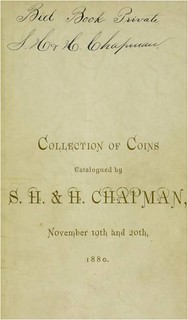 The auction catalogs of the brothers Chapman (Samuel H. and Henry), published in Philadelphia from 1879 - 1931, are among the most pursued by collectors of American numismatic literature. The Bushnell catalog (1882), in particular, was a shot across the bow, a large format emission with photographic plates that challenged the cataloging standards of the day. The competition could not remain silent, and Edouard Frossard offered a grudging review in his Numisma of May 1882. Frossard damned with faint praise, commenting “the carelessness in composition, indifferent grammar, and tautology, found in the former combined productions of Messrs. Chapman, have to a certain extent been avoided in this.” While Frossard could not deny the quality of material in the sale, he concluded his commentary with a final jab, noting “….collectors will always prefer a good coin ungrammatically described to a poor one enshrined in the flowery language of rhetoric.”
The auction catalogs of the brothers Chapman (Samuel H. and Henry), published in Philadelphia from 1879 - 1931, are among the most pursued by collectors of American numismatic literature. The Bushnell catalog (1882), in particular, was a shot across the bow, a large format emission with photographic plates that challenged the cataloging standards of the day. The competition could not remain silent, and Edouard Frossard offered a grudging review in his Numisma of May 1882. Frossard damned with faint praise, commenting “the carelessness in composition, indifferent grammar, and tautology, found in the former combined productions of Messrs. Chapman, have to a certain extent been avoided in this.” While Frossard could not deny the quality of material in the sale, he concluded his commentary with a final jab, noting “….collectors will always prefer a good coin ungrammatically described to a poor one enshrined in the flowery language of rhetoric.”
Critics aside, the Chapman’s made numismatic history, and today their catalogs are collected in all formats, with examples containing original plates being the most coveted. The catalogs in the series, 162 sales in all, exist in sufficient quantities that complete sets can be reasonably attempted. Certain of the plated catalogs are rare, but these can be substituted with lesser, unplated copies as collectors await their “white whale” on the auction or secondary market. While this is a justifiably popular endeavor, the bid book copies of the auction catalogs are decidedly more difficult.
The Chapman bid books were used by the Chapman’s to record the winning bid and name of the winning bidder for each lot. As such, each is unique, used during the sale to capture the necessary data for preparing invoices. A complete set of the Chapman bid books necessarily comprises exactly 162 examples, the majority of which today reside in the Dan Hamelberg collection. Hamelberg has generously loaned a group of these to the Newman Numismatic Portal for scanning, and this first group, all small format catalogs, is now online at https://archive.org/details/newmannumismatic?and[]=chapman.
A total of 84 bid books are here, representing over half of all Chapman sales. An announcement regarding the large format bid books will be made in the future.
The Chapman bid books were first featured on the secondary market in 1970, in the Harmer, Rooke February auction of that year. This sale included 51 examples. Prices were shockingly low, ranging from two to 34 dollars. These bid books largely went to either Harry Bass (reappearing in the Harry W. Bass. Jr. Numismatic Library sales, parts I and IV, 1998-2000) or Armand Champa (Parts I and III, 1994-1995). By now results easily reached into four-figure territory.
A second large group, completely complementary to the Harmer, Rooke group appeared in the John J. Ford, Jr. Reference Library Part I sale in 2004. Ford’s library contained 38 bid books. Hamelberg aggressively pursued the bid books at the Champa, Bass, Ford, and Craig Smith (who had purchased out of Bass) sales. It is thought that not all of the bid books survive, although other groups may exist outside the Hamelberg library. The American Numismatic Society retains a small number.
Not all bid books are created equal, and those for more important sales are more highly prized. The crème de la crème are those containing original plates, and these appear to have been a matter of chance – if an extra plated copy was still on hand at the time of the sale, it might have been used. Of the nine small format plated bid books in the Hamelberg collection, all passed through the John Ford library, with none represented in the Harmer, Rooke 1970 sale.
Whether picked by Ford or a predecessor, these seem to have been set apart as more “special” from an early date. George Kolbe, numismatic bookseller, is of the opinion that Ford likely had access to all of the bid books at some time prior to the 1970 Harmer, Rooke sale and simply ignored those he felt unimportant. The fact that none of the Harmer, Rooke books appear in the Ford library seems to corroborate this.
Again, thanks to the generosity of Dan Hamelberg, longtime literature collector and ANS Trustee, a substantial quantity of the bid books are now freely accessible, via the Newman Numismatic Portal, to all collectors and scholars within reach of the Internet. These contain information found nowhere else, tracing the ownership of thousands of rare coins through the late 19th and early 20th century.
Here we see, for example, John Clapp collecting high-grade branch mint coinage before anyone else was interested (Wetmore sale, 1906, https://archive.org/details/collectionofunit1906chap, lots 437, 438). In other places the Chapman’s record their administrative costs (Shorthouse sale, 1889, https://archive.org/details/catalogueofveryf1889chap, inside back cover), a rare insight into the financial side of the auction business in the 19th century.
There are many more stories hidden inside these special books, and their general availability, for the first time, will be welcomed by the numismatic research community.
CENTRAL STATES ANNOUNCES 2015 AUTHOR GRANTS
The Central States Numismatic Society has awarded $5,000 grants to five researchers to produce books and articles about numismatic subjects ranging from the national motto on coins to the signatures appearing on large-size national bank notes.
The Central States authors grant program, now in its fifth year, has awarded grants to 26 numismatic researchers. To date, the recipients have published 15 books, with several more in the pipeline. Education Director Ray Lockwood said, “Awarding monies to numismatic authors benefits everyone in our great hobby. There never can be enough numismatic literature.”
This year’s recipients are:
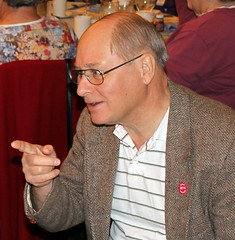 WILLIAM BIERLY for The Origin of the Motto: In God We Trust
WILLIAM BIERLY for The Origin of the Motto: In God We Trust
Bierly, whose exhibits on the evolution of the national motto have placed highly at American Numismatic Association and Central States Numismatic Society conventions, is taking his research a step further with the planned publication of a book on the subject. Bierly plans to use the grant to cover research and travel costs during the next year.
In his application, he wrote, “The purpose of the book I am proposing is to illuminate the origins of the motto ‘In God We Trust’ on U.S. coins and currency. I recall reading a quote some years ago from David Bowers to the effect that history and coin collecting often don’t intersect. He cited a conversation with a history professor, an expert of the Civil War, who had never heard of Civil War tokens, a popular collectible series among numismatists. In a way the professor was missing an element of what everyday life was like during the war as people struggled with making small change. It also reflected the larger issues of how the war was being financed and the longer term impacts on coinage and currency in the U.S. This story of the motto provides a perfect example of that intersection between history and numismatics as both the study of the coins and of the documentary history surrounding them are necessary for a fuller understanding of the story.”
The book, he said, will not end with the 1864 placement of the motto on coins. “Finally,” he wrote in his application, “ there will be a chapter dealing with how the motto has fared since the Civil War and how it continues to be the focus of controversy and strong opinions pro and con. “
KEVIN FLYNN for The Authoritative Reference on Liberty Seated Quarters and Authentication of Rare Dates and Die Varieties
Flynn, who has written 49 books on a wide variety of numismatic subjects, plans to use his grant to cover photography and printing expenses for two books covering Seated Liberty quarter dollars and rare dates and varieties of several series.
In his application, he wrote, “I have already completed authoritative type books on the Liberty Seated half-dimes, twenty cent pieces, and dollars. The Authoritative Reference on Liberty Seated Quarters is the next book in the series and will present a complete analysis of the history, individuals who were involved in the creation or changes to this series, all design changes, all die varieties including multiple micro photographs and a detailed description of the variety and all diagnostics, archive letters, and a thorough examination of all hot topics for this series.
He wrote, the objective of the rare date and variety book “is to present the top coins and die varieties, such as the 1916-D Mercury dime or 1918/7-S Standing Liberty quarter and to present close up photographs of diagnostics and design elements such as the date and mint mark, to assist in identification and verifying that it your coin is not a counterfeit.”
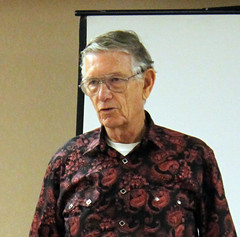 PETER HUNTOON for articles on Treasury signatures on large size national bank notes
PETER HUNTOON for articles on Treasury signatures on large size national bank notes
Huntoon, a noted writer, researcher and speaker on national bank notes, plans to use his grant to cover travel expenses while he researches signature combinations on national bank notes.
In his application, he said, “Treasury signature combination collecting faded in popularity after John Hickman diverted collector attention to collecting by location beginning in the mid-1960s. Town, county and state collectors could have cared less about the signatures on their notes, so auction cataloguers and dealers stopped paying much attention to them. That attitude is passing. The entry price for admission to serious location collecting has shut out newbies, so some of them - and some frustrated seasoned location collectors - are giving Treasury signature collecting a rebirth.”
He wrote, “The numismatic community has determined qualitatively which Treasury signatures are scarce in the various series based on a feel for how frequently they have gone by. There is no publication that: (1) explains why given signatures are rare on the various series or (2) provides a list of the rare ones by bank, series, sheet combination and serial number range.
“The reason for this is that: (1) the job of figuring out which combinations were issued in which series is tricky and (2) screening out exactly which ones carry the rare signatures is daunting because one has to sift through 52,000 proofs in the National Numismatic Collection and perform very sophisticated analyses on the National Currency receipts ledgers in the National Archives to get the answers.
“It is my opinion that collectors should be armed with definitive information on exactly why certain signatures are rare in general and others are rare only on selected types. Every possible signature combination on every type should be determined. Then I believe collectors should have a definitive list of exactly which banks issued the rarities along with the sheet combinations and serial numbers.” Huntoon plans to publish his findings as a series of articles in Paper Money, the publication of the Society of Paper Money Collectors.
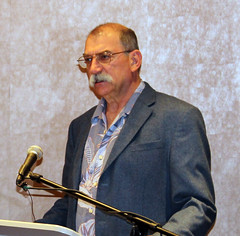 ALLAN SCHEIN for The $2.50 and $5.00 Gold Indians of Bela Lyon Pratt.
Schein, author of the recently released Mexican Beauty - Belleza Mexicana, Un peso Caballito, said the grant will be used to help pay for printing the book about Bela Lyon Pratt’s incuse $2.50 and $5 Indian head gold coins, minted from 1908 to 1929.
ALLAN SCHEIN for The $2.50 and $5.00 Gold Indians of Bela Lyon Pratt.
Schein, author of the recently released Mexican Beauty - Belleza Mexicana, Un peso Caballito, said the grant will be used to help pay for printing the book about Bela Lyon Pratt’s incuse $2.50 and $5 Indian head gold coins, minted from 1908 to 1929.
He said, “This book is already a work in progress. The granddaughter of Bela Lyon Pratt has been gracious in allowing me extensive use of archived family documents, including more than 1,000 personal letters and numerous photographs heretofore unpublished in numismatic works. Sadly, Cynthia Kennedy Sam passed away June 8th, 2015, but was happy I was writing this book and the way I was doing it; with significant emphasis on her grandfather. In part, this book is a testament to her extensive work as the Pratt family historian, as without her years of dedication to preserve Bela's legacy, this book and the story of a great and prolific talent would be incomplete.”
He anticipates completing the book next spring.
 GERALD TEBBEN and JOHN ROBERTS for Columbus, Ohio, Civil War Tokens.
GERALD TEBBEN and JOHN ROBERTS for Columbus, Ohio, Civil War Tokens.
The book by Tebben, numismatic writer and editor; and Roberts, coin author and VAM expert, builds on Tebben’s 1998 monograph on the merchants who issued tokens in Columbus during the Civil War. The book will be illustrated with photographs from Roberts’ of every known die marriage as well as off-metal tokens.
The book, which is expected to be completed during the first quarter of 2016, expands beyond the city’s nine Civil War token issuers to include sections on Merchants Exchange, a post-war issuer of tokens that was mistakenly included in the first edition of George and Marvin Fuld’s U.S. Civil War Store Cards; sutler tokens issued for Camp Chase, a massive Confederate Prisoner of War camp on the city’s west side; and scrip issued in the names of the token issuers.
While Columbus is well north of the Mason-Dixon line, the city was home to many Confederate sympathizers, a circumstance that sometimes complicated the lives of some of the city’s token issuers.
Lockwood noted, “Central States prides itself on its many education programs and the collectors, clubs and dealers that benefit from our efforts.” In addition to the authors grant program, Central States provides member clubs with grants to purchase numismatic books for schools and libraries and helps fund speaker fees.
For more information on the Central States Numismatic Society, see:
www.centralstates.info

Archives International Auctions, Part XXIX
U.S. & Worldwide Banknotes, Scripophily, Coins,
Historic Artifacts & Ephemera, Artwork, Autographs
and Security Printing Ephemera
October 24th & 29th, 2015

Click the links! Highlights include:
- Lot 26: Thomas Spencer - Honolulu - Sandwich Islands 1858
- Lot 320: Accelerating Steam Navigation Co. 1841 Ten shares
- Lot 363: Confederate States Bond. $10,000. Cr.146, B-339.
- Lot 413: First Liberty Loan Converted 4 _% Gold Bond of 1932-1947
- Lot 607: Fijian Government Debenture, 1872 Issue
- Lot 715: Bono De Caja, El Banco Comercial Refaccionario De Chihuahua
- Lot 738: Banco Nacional Del Peru, 1877 Provisional Issue Specimen
- Lot 809: Bank of Zambia, ND (1964) Specimen Banknote.
- Lot 948: British American Bank Note Company Engravers & Printers Proof
- Lot 960: Draper, Underwood, Bald & Spencer, ND, ca.1820's Sample Sheet.
- Lot 1000: Colonial Pennsylvania, 15 Shillings 5.20.1758.
- Lot 1056: Cherokee Insurance & Banking Co. 2 Dollars. 1862.
- Lot 1139: Bank of America, 1879 Specimen $10,000 Clearing House Certificate.
- Lot 1148: Manufacturers Bank, 184x Proof Banknote on a Proof Vignette Sheet
- Lot 1229: Confederate States. 5 Dollars. 1861.
- Lot 1280: Legal Tender Note. 1863 Series. 5 Dollars.
- Lot 1298: Hackettstown National Bank of NJ., Second Charter $10.00
View the Virtual Catalog
Download the Catalog in PDF format
ARCHIVES INTERNATIONAL AUCTIONS, LLC
1580 Lemoine Avenue, Suite #7
Fort Lee, NJ 07024
Phone: 201-944-4800
Email: info@archivesinternational.com
WWW.ARCHIVESINTERNATIONAL.COM
LAKE BOOKS 123RD SALE CLOSES OCTOBER 27, 2015
This is a reminder that Lake Books’ 123rd mail-bid sale of numismatic literature closes on Tuesday, October 27, 2015 at 5:00 PM (DST). The 481-lot sale contains reference material on a wide variety of subjects in the numismatic experience including books on Greek and Roman coinage, wonderful photographs of Early American coins, Tokens and Medals are extensively covered and be sure to look at the Miscellaneous category. You can view the catalog at http://www.lakebooks.com/current.html and bids can be placed via email, fax, or telephone until the closing time.
Good Luck with your bidding, Fred
Lake Books
6822 22nd Ave N
St. Petersburg, FL 33710-3918
727-343-8055 fax: 727-381-6822
SIATRAS INTERNATIONAL BOOKSHOP WEEKLY SALES
He writes:
Every week, Siatras International Bookshop will offer one numismatic title at deep discount ! This week's book (at 75% discount) is "Ancient Jewish Coinage: Persian Period through Hasmonaeans".
For more information, see:
http://booksoncoins.blogspot.gr/

JASON PHIPPS'S MEMORANDUM BOOK FOR BANK BILLS
Jason Phipps's Memorandum Book for Bank Bills, 1806
by Phipps, Jason
Published 1806
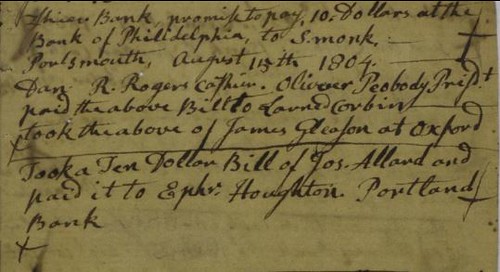
This is a notebook kept by Jason Phipps to protect his interests in case he received counterfeit bank notes. For each bill he records date of receipt, description of note (denomination, bank, serial number and signers), and from whom it was received. The dates range from 1806 to 1814.
Year 1806
Pages 29
Language English
To read the complete book, see:
Jason Phipps's Memorandum Book for Bank Bills, 1806
(https://archive.org/details/jasonphippsmemor1806phip)
EASTMAN'S TREATISE ON COUNTERFEIT BANK NOTES
 Eastman's Treatise on Counterfeit, Altered and Spurious Bank Notes
Eastman's Treatise on Counterfeit, Altered and Spurious Bank Notes
by Eastman, H.G.
Published 1859
Topics Counterfeits and counterfeiting
The extended title reads: "With unerring rules for the detection of frauds in the same, together with a history of ancient money, continental currency, banks, banking, Bank of England, and other valuable information as to MONEY, with hints to business success."
Volume 1859
Pages 72
Language English
Digitizing sponsor Eric P. Newman Numismatic Education Society
Book contributor Washington University Libraries

To read the complete book, see:
Eastman's Treatise on Counterfeit, Altered and Spurious Bank Notes
(https://archive.org/details/eastmanstreatise1859east)

MUSEUM OF AMERICAN FINANCE EXHIBIT: WORTH ITS WEIGHT
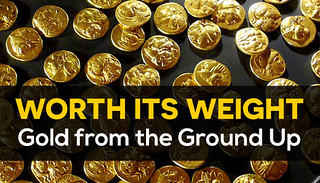 On November 19, the Museum of American Finance will open “Worth Its Weight: Gold from the Ground Up,” an exhibit that will captivate visitors with the many spectacular and unexpected ways gold has influenced our lives – from science and technology to entertainment and pop culture to finance and economics. The exhibit will be featured in three galleries and the Museum’s theater and will be on view through December 2016.
On November 19, the Museum of American Finance will open “Worth Its Weight: Gold from the Ground Up,” an exhibit that will captivate visitors with the many spectacular and unexpected ways gold has influenced our lives – from science and technology to entertainment and pop culture to finance and economics. The exhibit will be featured in three galleries and the Museum’s theater and will be on view through December 2016.
“We are excited to showcase more than 100 stunning gold objects from over a dozen public and private collections in this unique exhibit on Wall Street,” said David Cowen, the Museum’s president.
The “Gold in America” gallery will feature three subject areas – Gold Rushes, Finance and Mining & Refining – exploring how the story of gold is intimately intertwined with American history. “The Many Faces of Gold” section will showcase vignettes about the myriad uses for gold and its meaning around the world, including how the concept of “gold” has become a symbol of “the best.”
The most familiar relationship people have with gold is through jewelry and adornment. The “Jewelry Box” room will focus on the luxury and glamour of gold jewelry and décor, with several unique objects on loan from collections around the country including the Smithsonian Institution, the Tiffany & Co. Archives and jewelry designer Marla Aaron. The “Midas Touch” room will feature the creations of Sidney Mobell, a modern day Midas who transforms everyday items into dazzling gold and jeweled artworks, challenging the relationship between the mundane and the luxurious.
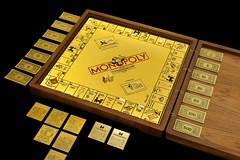 “The 17 objects designed by world-renowned jeweler Sidney Mobell – from an 18-karat gold Monopoly set to a diamond, ruby and sapphire encrusted cell phone – are unique works of art that will bring a lot of pleasure to the visiting public,” said Cowen.
“The 17 objects designed by world-renowned jeweler Sidney Mobell – from an 18-karat gold Monopoly set to a diamond, ruby and sapphire encrusted cell phone – are unique works of art that will bring a lot of pleasure to the visiting public,” said Cowen.
“Worth Its Weight” is sponsored by Apple co-founder Steve Wozniak and Sidney Mobell, with additional support from the International Precious Metals Institute (IPMI), Van Eck Gold Funds and Loomis. The exhibit is supported, in part, by public funds from the New York City Department of Cultural Affairs, in partnership with the City Council.
More information on this exhibit, including a list of object highlights, can be found at www.moaf.org/exhibits/gold .
AN UPDATE ON MING DYNASTY NOTES
Recently on Pocket Change I wrote about Chinese Ming paper notes. Afterward, I was pleased to hear from an expert on the subject, Bruce Smith, who has been studying Chinese coins and paper money for forty years. Most of the information he conveyed comes from a talk he gave at the Chicago International Coin Festival in April 2013.
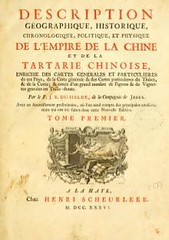 The earliest western description of the Ming notes that Bruce could find comes from The General History of China, a translation of a 1736 French work by Jean Baptiste DuHalde that was a compilation of reports by Jesuit missionaries. Early descriptions can also be found in articles by John Williams for the Numismatic Chronicle (1863 and 1864) and in two Journal Asiatique articles, “Sur l’Origine du Papier Monnaie” by Jules Henri Klaproth (1822) and “Memoire sur le Systeme Monetaire des Chinoises” by Edouard C. Biot (1837).
The earliest western description of the Ming notes that Bruce could find comes from The General History of China, a translation of a 1736 French work by Jean Baptiste DuHalde that was a compilation of reports by Jesuit missionaries. Early descriptions can also be found in articles by John Williams for the Numismatic Chronicle (1863 and 1864) and in two Journal Asiatique articles, “Sur l’Origine du Papier Monnaie” by Jules Henri Klaproth (1822) and “Memoire sur le Systeme Monetaire des Chinoises” by Edouard C. Biot (1837).
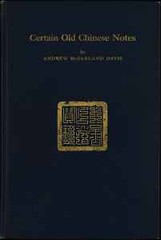 In the twentieth century, much of the writing on early Chinese notes, including the article by John Sandrock (parts 1&2) cited in my original post, was based on the research of Andrew McFarland Davis in the 1910s. Davis, an authority on U.S. Colonial notes, stepped outside of his area of expertise when he published descriptions and illustrations of early Chinese notes taken directly from Ch’uan Pu T’ung Chih, a work supposedly compiled in the early nineteenth century. The resulting study by Davis and translator Kojiro Tomito, Ancient Chinese Paper Money as Described in a Chinese Work on Numismatics (1918), was used by subsequent writers such as Henry Ramsden and Howard Bowker.
In the twentieth century, much of the writing on early Chinese notes, including the article by John Sandrock (parts 1&2) cited in my original post, was based on the research of Andrew McFarland Davis in the 1910s. Davis, an authority on U.S. Colonial notes, stepped outside of his area of expertise when he published descriptions and illustrations of early Chinese notes taken directly from Ch’uan Pu T’ung Chih, a work supposedly compiled in the early nineteenth century. The resulting study by Davis and translator Kojiro Tomito, Ancient Chinese Paper Money as Described in a Chinese Work on Numismatics (1918), was used by subsequent writers such as Henry Ramsden and Howard Bowker.
Unfortunately, according to Bruce, the Chinese book on which it is based is a fraud. “All of the notes listed and illustrated in the work are bogus fantasies—they never existed,” he says, so any work based on Davis’s writings are suspect, including the Sandrock article.
Incidentally, one of the frustrating things about the online version of the Sandrock article is the absence of a date or the name of the journal where it was originally published. Bruce cleared that up too. A brief article by Sandrock on topic appeared in the Currency Collector (v.4 n.1, Spring 1963). The source of the online version appears to be Numismatics International’s NI Bulletin (part 1, Nov. 2003; part 2, Dec. 2003).
Finally, Bruce also points out that, while the Ming one kwan (or guan) notes were indeed first made in the late fourteenth century, they continued to be printed and circulated into the sixteenth, so surviving examples, including those in the ANS collection, could come from the later period. I would like to thank Bruce for contributing so much on this fascinating topic.
To read the complete article, see:
CHINESE NOTES UPDATE: BEWARE OF WORKS BASED ON A FRAUD
(www.anspocketchange.org/chinese-notes-update-beware-of-works-based-on-a-fraud/)
To read the earlier E-Sylum article, see:
MING DYNASTY NOTES: OLD, BUT NOT RARE
(www.coinbooks.org/esylum_v18n35a27.html)

POGUE PART III COIN IMAGES AVAILABLE
Saul Teichman writes:
For those people who want a sneak peek at Pogue III coins, images are now available on the Stack's Bowers web site. The description showing is still Pogue Part II but the coin listing is actually Pogue part III.
Lot 3002:
1793 Liberty Cap Half Cent. Head Left. C-3.
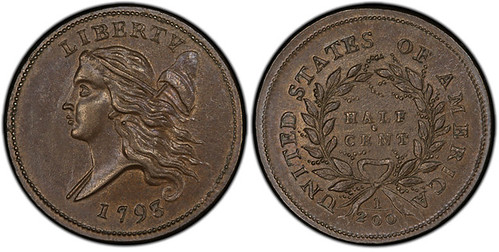
Lot 3003:
1794 Liberty Cap Half Cent. C-4a. Small Edge Letters.

Lot 3015:
1793 Flowing Hair Cent. Wreath Reverse. S-9.
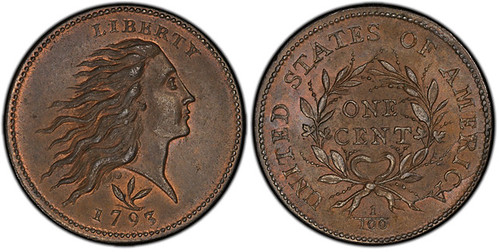
Lot 3021:
1821 Capped Bust Dime. JR-6. Large Date.
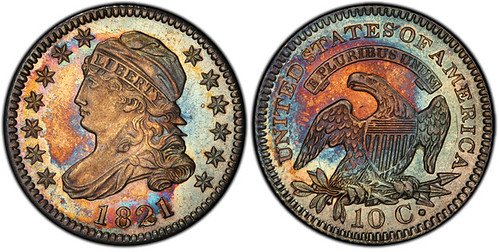
Lot 3051:
1823 Capped Bust Half Dollar. O-110a. Ugly 3
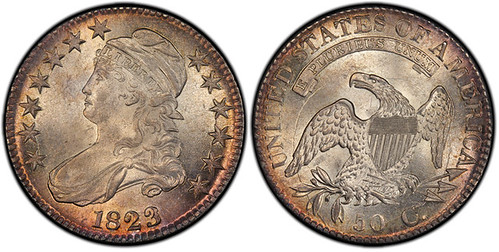
To view the complete photo set, see:
The D. Brent Pogue Collection, Part III
(http://media.stacksbowers.com/poguecollection/pogue-coin-list_3.html)
NOTES FROM E-SYLUM READERS: OCTOBER 25, 2015
An A.J Fink Customer Dave Schenkman writes:
The mention of A. J. Fink reminded me that I was actually a customer of his. In the 1950s I bought a 1916 standing Liberty quarter from him. It was supposedly uncirculated and cost $100, which was a lot for me to spend as a teenager.
To read the earlier E-Sylum articles, see:
ALVIN JOHN FINK (1875-1965)
(www.coinbooks.org/esylum_v18n41a17.html)
NOTES FROM E-SYLUM READERS: OCTOBER 18, 2015 : More on A. J. Fink
(www.coinbooks.org/esylum_v18n42a11.html)
More on The Yoachum Dollars Tom DeLorey writes:
The Yoachum Dollars mentioned here a month ago are modern hoaxes. I tried to post a reply to that "News Hub" site but could not.
Two of these came into ANACS when I was there 1978-1984. We did elemental analysis and found them to be near-perfect sterling silver, 92.5% silver 7.5% copper with no significant trace elements. You can get this by melting down old sterling silverware or Franklin Mint medals.
They are not made from crudely-refined native silver.
To read the earlier E-Sylum article, see:
NOTES FROM E-SYLUM READERS: OCTOBER 18, 2015 : More on the Yoachum Dollar
(www.coinbooks.org/esylum_v18n42a11.html)
Missouri Curio Cabinet of Half Cents Mark Borckardt forwarded this item from Heritage Auctions:
Offered in a special cataloged internet sale at HA.com (Sale 131599), with bidding open on October 28, and closing November 8, 2015.
80 half cents from the combined collection of Eric P. Newman and R. Tettenhorst, with a special collection name to distinguish these coins from the primary Missouri Cabinet sale.
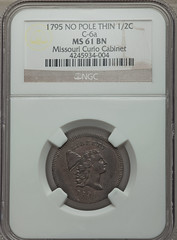 Highlights include:
1793 C-4 Planchet Lamination AU58 NGC with large obverse lamination
Highlights include:
1793 C-4 Planchet Lamination AU58 NGC with large obverse lamination
1795 C-6a Double Struck VF30 NGC
1795 C-6a Over TAL Token AU55 NGC
1795 C-6a MS61 Brown NGC
1804 C-8 Spiked Chin MS63 Brown NGC
1809 C-5 MS64 Brown NGC
1826 C-2 XF Details NGC
1846 Original B-1 PR62 Brown NGC
All 80 lots will be available for viewing at our New York office, Oct. 26-29, and in Dallas from Nov. 2-6.
To view the online coin listings, see:
Missouri Curio Cabinet of Half Cents
(http://coins.ha.com/c/search-results.zx?Ne=35&N=793+792+3183+4294948974&ic4=Refine-071515)
Blondie: Women on Money Howard Berlin writes:
At the start of each morning I usually look at a number of cartoons on the internet (Garfield, Haagar, Marmaduke, The Born Loser, etc.). Today's Blondie 'toon below is about women on our money.

26 Fun Facts about Money Heather Schena writes:
I found this video and thought I'd pass it along.

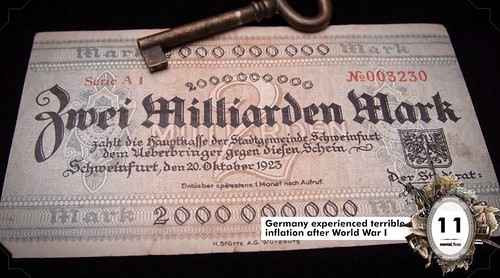
To view the complete video, see:
26 Fun Facts about Money - mental_floss List Show Ep. 330
(https://youtu.be/SXSQ0twYEQ4)
Halloween in Florida
 This is totally non-numismatic, but amusing nonetheless. Harvey Stack forwarded this image of Halloween in the retiree haven of Florida. Thanks.
-Editor
This is totally non-numismatic, but amusing nonetheless. Harvey Stack forwarded this image of Halloween in the retiree haven of Florida. Thanks.
-Editor
THE BOOK BAZARRE
SECOND THIAN MASTER CONFEDERATE CURRENCY ALBUM
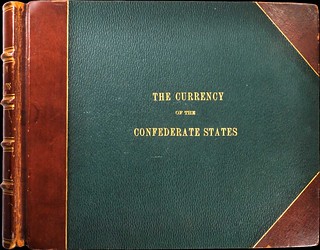
The Sept 20th E-Sylum (Vol 18-#38) had an article by Brad Ciociola of Stack’s Bowers about a newly discovered Thian Master Confederate Currency Album. These are extremely rare with only about six or so previously known, and this one was estimated to bring $60,000 to $80,000. Concerning the album’s condition, Mr. Ciociola noted that “The front cover and a few inner leaf pages have detached along with the spine of the book. All but the spine are present and could be reattached by an expert book restorer.”
When Stack’s Bowers displayed the newly discovered Album at the 2015 Blue Ridge Numismatic Association annual convention, several notable Confederate dealers suggested that the next owner should have the album restored to reattach the front cover and replace the spine. Stack’s then learned at the show that a matching album, minus most of the notes, was known and could be used to restore the album that had been consigned. The owner of the second album agreed to consign it to this auction in order to allow it to be used to restore the full album.
This second example was a victim in the past of a razor blade with the bulk of the pages and notes removed, but it still contains ten Confederate notes from 1864. The cover and spine are in excellent condition with THE CURRENCY of the CONFEDERATE STATES in gold leaf on the front cover and the spine. In the upcoming Stack’s Bowers November 2015 Baltimore Auction, this second Thian Master Album will be offered right after the newly discovered Album and is estimated at $3,000 to $5,000. It is hoped that this album will be used to restore the first one - there will most likely never be a better opportunity to acquire the elements necessary. From Stack’s Bowers November 2015 Baltimore Auction Catalog……….
To read the complete lit descriptions, see:
Confederate Currency. The Currency of the Confederate States. Master Album by Rafael Thian. Circa 1906. Contains 287 Pieces.
(www.stacksbowers.com/BrowseAuctions/LotDetail/
tabid/227/AuctionID/6110/Lot/30174/Default.aspx)
onfederate Currency. The Currency of the Confederate States. Partial Master Album by Rafael Thian circa 1907. Contains 10 pieces.
(www.stacksbowers.com/browseauctions/lotdetail.aspx?
AuctionID=6110&Lot=30175)
To read the earlier E-Sylum article, see:
THIAN MASTER CONFEDERATE CURRENCY ALBUM OFFERED
(www.coinbooks.org/esylum_v18n38a15.html)
GREEN & RUSSELL, COLONIAL BOSTON MEDAL DEALERS
He's been working for years researching 18th century American numismatists and dealers, and has uncovered quite a bit of information that pushes back our knowledge of this area by over a century. His book will be titled Numismatic Collecting in 18th Century America.
This week's subject is the firm of Green & Russell, colonial Boston auctioneers and medal dealers. As always, this is an excerpt with the full article and bibliography available online. -Editor

Boston Post-Boy, Monday, February 15, 1762, page 3.
“Left at Green & Russell’s Printing-Office for SALE. A Parcel of Curious Medals of the KING and QUEEN, neatly done in yellow and white Mettal, [Price 6 Coppers single,] ☞ Good Allowance will be made to those who buy by the Dozen.”
Boston Post-Boy, Monday, February 15, 1762.
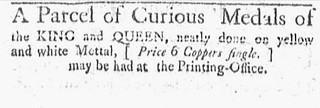
Boston News-Letter, Thursday, February 11, 1762, page 3.
"A Parcel of Curious Medals of the KING and QUEEN, neatly done on yellow and white Mettal, [Price 6 Coppers single,] may be had at the Printing-Office."
An unspecified quantity of medals was left at “Green & Russell’s Printing Office”, which is the office of the publishers John Green (1715/7-1787), and Joseph Russell (1734-1795), of the newspaper the Boston Post-Boy and Advertiser, the successor to or continuation of their former paper, Boston Weekly Advertiser (1757-1759).
John Green was born in 1717 at Boston the son of Bartholomew Green, Jr. His great-grandfather Bartholomew Green who came to America in 1632 together with his grandfather Samuel Green of Cambridge printed the Indian Bible. He was an apprentice to the printer John Draper who published the Boston News-Letter. Green died in November 1787.
Green and Russell formed a partnership in 1755. “A few years afterward, Russell opened an auction office, the profits of which were shared by the firm. Green managed the printing office and Russell took charge of the auction room.” Russell had been an auctioneer in Boston at least four if not five years by this time. He was the most prominent auctioneer in Boston. Isaiah Thomas credits only Joseph Russell as auctioneer but reading through the newspapers frequently the auctions advertised give J. G., Auctioneer. Apparently both men were active in auction sales at their office. Anyone reading this advertisement to come to the “Green & Russell’s Printing Office”, would know and understand it was Green’s and Russell’s auction store.
Undoubtedly, the parcel containing the medals was consigned to either twenty-eight year old Joseph Russell or forty-five year old Green to auction them off in larger quantities in batches based on a unit of a dozen since there was no fixed price for bulk lots. The only fixed price established in the advertisement was 6 coppers for a single medal. Since we know copper farthings and halfpence were in circulation at Boston at this time it seems tenable that the price set for a single medal was one and a half penny or 6 farthings. Apparently that was the high end of the market price for one and a retailer buying by the dozen or gross would expect to pay only a fraction of that in order to turn over a profit. It is in this variability that auction bids, either in a live public auction forum or silent auction or sealed bids, typically called a private sale that determined at what rate buyers were to pay per item.
The above cited medal auction was inadvertently deleted from my book manuscript that was published as American Numismatic Auctions to 1875, Volume 1 : 1738-1850. Since publication new material has been collected and a fuller completely revised edition is planned to be published either separately or combined with Volume 2 : 1851-1875. This auction should have been entry No. 9, Coin Auction No. 4. These earliest auctions from 1738-1762 were of numismatic literature, scrip, King of Prussia medals, freemason medals, and English medals of the King and Queen. Those who bought my book might want to print this page as an additional addendum. Apologies to all; mea culpa, mea culpa, mea maxima culpa.
The Wedding Medal that Green & Russell sold is not precisely known but is perhaps identical with that formerly in the DiLauro Collection, now in the ANS, as described below or those in brass and pewter in the British Museum. There were numerous Wedding Medals struck in great variety complicating the identification of which medal precisely was sold at Boston in February 1762, five months (115 days) after their distribution at London. Considering the voyage from London to Boston averaged about seven weeks, this shipment must have left London about two months after the wedding suggesting these were the remaining unsold pieces seeking a market elsewhere by those patented to mint or sell them.
The costs of manufacture, shipping and distribution of these medals was probably about half the price, which in 1762 Boston, Green & Russell set at the high end of one and a half penny. A shopkeeper had an incentive to purchase a dozen or more at wholesale since he could turn over a reasonable profit. The scarcity of American surviving specimens is most probably attributed to the rebels during the Revolutionary War who would have either aimlessly destroyed them or melted them to make utensils.
George III (reign 1760-1820), married Princess Charlotte Sophia (1744-1818), daughter of Louis Frederick, Duke of Mecklenburg-Strelitz on September 8, 1761. Sir Joshua Reynolds was commissioned to paint the marriage scene inside Westminster Abbey. The royal engravers were given the task to produce a series of commemorative medals to celebrate the event. The medals were distributed on Tuesday, September 22, 1761 at the coronation ceremony in Westminster Abbey. The various varieties (BHM 12 and 17, Jamieson 10, Betts 440, etc.) correspond to the intended recipients. Those struck in gold and silver were given to the nobility. Those in bronze, brass, pewter are most probably those here described as white metal for the masses.
There were several wedding medals issued and one or more is cited in this ad. The description given in this ad fails to elucidate either the quantity or any physical description or legend to assist in identifying a specific variety. The British Museum has brass and pewter wedding medals fitting the description published in this auction advertisement as “yellow and white metal,” M.4679 (brass), 1906,1103.398 (brass); and M.4642 (pewter). The ANS has one in white metal 1975.248.2 (BHM 34), donated from the DiLauro Collection. This DiLauro specimen is most probably a survivor of the many dozens that were sold in this auction sale. The BHM 48 issued in brass and copper was designed by an unidentified engraver.
Besides the brass and pewter medals others, as we have already noted, were struck in gold, silver and bronze.
To read the complete article, see:
GREEN & RUSSELL
(https://sites.google.com/site/numismaticmallcom/encyclopedic-dictionary-of-numismatic-biographies/green-russell)
FINKELSTEIN ON DR. DAVID RITTENHOUSE – PART 2
By David Finkelstein
Introduction
This is part 2 of a series of articles about Dr. David Rittenhouse, the first Director of the United States Mint. Over the last few decades, multiple incorrect statements and theories about events during his lifetime and after his death have been published in numerous numismatic articles and publications. These falsities have been perpetuated simply because they were put in print, without any contemporary evidence to validate them. They have become accepted as being factual. They are not.
Falsity #2 – David Rittenhouse Was Bankrupt or Near Bankrupt When He Died
In Part 1, it was stated that a few researchers theorized that David Rittenhouse was incarcerated in the Pruan Street (or Prune Street) debtor’s prison during 1796, 1797 and 1798, and that he, in fact, did not die in 1796. His June 26th death, June 27th burial, and December 17th Eulogium was suggested to have been a massive cover up to maintain the integrity of his image and to protect his reputation.
In order for David Rittenhouse to have been incarcerated in debtors’ prison, his debts had to have been greater than his assets, he had to have been the defendant in a bankruptcy court case, and he had to have been sentenced to debtors’ prison by a judge. At the time of his death, David Rittenhouse owned multiple real estate properties; including land in Norriton, PA that was deeded to him by his father in 1770. In addition, he had a significant holding of personal property and stock, and he made multiple interest bearing loans to others. Had David Rittenhouse been incarcerated in debtors’ prison any time after 1770, the Norriton property that he owned since 1770 would have been sold prior to his incarceration. See below.
David Rittenhouse’s Last Will and Testament
Daniel K. Cassel, in his 1893 book titled Genea-Biographical History Of The Rittenhouse Family And All Its Branches In America, With Sketches Of Their Descendants, reprinted David Rittenhouse’s last will and testament on pages 164, 165 and 166. Cassel identified Rittenhouse’s will as being “taken from the records, which is found recorded in Book X, page 475, No 66, at Philadelphia, in the year 1796”. Assets identified in David Rittenhouse’s last will and testament included:
- 72 acres 148 perches of land and a messuage (dwelling house with outbuildings) in Norriton, PA, that, at the time of his death, was being utilized by his sister, Eleanor Evans,
- His primary residence; a messuage near Mulberry (or Arch) and Seventh Streets in Philadelphia (that was purchased from John Bull on May 27, 1786),
- a 500 pound interest bearing loan to Isaac Snowden of Philadelphia,
- 10 shares of capital stock of the Bank of the United States, and
- 5 shares of capital stock of the Bank of North America.
David’s father, Matthias, deeded him the Norriton property on January 12, 1770. Cassel reprinted the deed on pages 169, 170 and 171 of his book. Note that Rittenhouse’s first astronomical observatory was built in 1769 on the Norriton property. His second observatory was built on his property near Arch and Seventh Streets.
Isaac Snowden was identified in the 1791, 1794, 1795 and 1796 Philadelphia Directories as a gentleman, located at 141 South Second Street. In 1796, one U. S. dollar was the equivalent of 0.2333 pounds, therefore the 500 pound interest bearing loan was the equivalent of $2,143.00.
Inventory of David Rittenhouse’s Personal Property
Andrew Ellicott and David Evans itemized David Rittenhouse’s personal property on September 16, 1796. Their document was affirmed, also on September 16th, before “I. Wampole, Dep. Reg.”. Rittenhouse’s itemized personal property was reprinted on pages 167 and 168 of Cassel’s book.
- Andrew Ellicott was identified in the 1796 Philadelphia Directory as Geographer General of the United States, and a Councillor of the American Philosophical Society (APS). When he died, David Rittenhouse was President of the APS. Rittenhouse and Ellicott were most likely very close friends.
- Although there were three David Evans identified in the 1796 Philadelphia Directory, David Evans above was most likely David Rittenhouse’s nephew; the son of his sister – Eleanor Rittenhouse Evans.
- Isaac Wampole was identified in the 1796 Philadelphia Directory as a scrivener (a scribe and/or notary).
David Rittenhouse’s personal property, included (but was not limited to):
- A 1,500 pound (or $6,430.00) bond and warrant from Robert Smock dated February 9, 1792. Robert Smock was identified in the 1794 Philadelphia Directory as a merchant, located at 145 High Street.
- A 1,000 pound (or $4,286.00) bond from Thomas Ketland Jr. dated March 6, 1794. Thomas Ketland was identified in the 1794 Philadelphia Directory as a merchant, located at 3 Walnut Street. In 1795, he was identified as a compting house (or an accountant), located at 5 Walnut Street.
- A 500 pound (or $2,143.00) bond from Joseph Watkins dated May 5, 1795. Joseph Watkins was identified in the 1794 Philadelphia Directory as a cabinet and chair maker, located at 121 Mulberry (or Arch) Street. In 1795 and 1796, he was identified as a gentleman.
- A 200 pound (or $857.00) bond, also from Joseph Watkins, dated August 6, 1795.
- A 100 pound (or $428.00) bond from Jacob Driesbach and Michael Reiver, payable May 27, 1797. Neither of these individuals were identified in the 1794 through 1799 Philadelphia Directories.
- A second 100 pound (or $428.00) bond from Jacob Driesbach and Michael Reiver, payable May 27, 1798.
- A 31 pound (or $133.00) bond from Jacob Driesbach and Michael Reiver, payable May 27, 1799.
- 2,625 pounds (or $11,252.00) in 6% stock. (The specifics of the stock were not specified.)
- 203 pounds (or $870.00) in 3% stock. (The specifics of the stock were not specified.)
- 10 shares of capital stock of the Bank of the United States,
- 5 shares of capital stock of the Bank of North America, and
- 1 share in the Delaware & Schuylkill Canal (that had no value in 1796).
Each share of capital stock of the Bank of the United States initially sold for $400.00 in 1792. Shortly thereafter, the value of each share rose to $600.00. At the time of Rittenhouse’s death, the 10 shares were valued at 1500 pounds (or $6,429.00). Each share of capital stock of the Bank of North America initially sold for $400.00. At the time of Rittenhouse’s death, the stock was valued at 750 pounds (or $3,215.00).
David Rittenhouse’s personal property was valued at 8,941 pounds ($38,324.00). As Director of the Mint, Rittenhouse was paid a salary of $2,000.00 per year. His salary ranged from 4 to 10 times that of the Mint workmen that were in his employ. As former chief executive officer of the United States Mint, the value of Rittenhouse’s personal property at the time of his death was valued at more than 19 times his annual salary.
Today, any executive that has 19 times his annual salary in personal property, excluding his real estate, would be a multi-millionaire.
The Rittenhouse Observatory
David Rittenhouse’s primary residence, near Arch and Seventh Streets, included real estate (69 ½ feet in front on Arch Street and 112 feet in length on Seventh Street), his home, and an Observatory. On September 16, 1796, the American Philosophical Society (APS) formed a committee to meet with Hannah Rittenhouse, David’s widow, regarding the Rittenhouse Observatory. Per page 241 of Early Proceedings of the American Philosophical Society for the Promotion of Useful Knowledge, Compiled by one of the Secretaries, From the Manuscript Minutes of its Meetings, From 1744 to 1838:
Coxe, W. Barton, Bleakley, Patterson, Committee to "confer with Mrs. Rittenhouse on a proposal made by her through Dr. Barton relative to investing the Observatory of the late President in the Society."
On October 7, 1796, an agreement was made between the APS and Mrs. Rittenhouse:
Mrs. Rittenhouse having expressed to the Committee "a desire to invest in the Society the Observatory, with a certain quantity of ground leading thereto,
"Resolved that this Society will with the greatest pleasure accept of the trust."
On March 10, 1797, the deed for the land and the Rittenhouse Observatory was provided to the APS by Hannah Rittenhouse.
Conclusions
Since David Rittenhouse owned real estate and personal property at the time of his death, he could not have died in debtors’ prison. Had he been incarcerated in debtors’ prison after January, 1770, he would not have owned the 72 acres 148 perches in Norriton, PA that was part of his estate in 1796. Likewise, had he been incarcerated in debtors’ prison after May, 1786, his widow could not have deeded land and the Rittenhouse Observatory near Arch and Seventh Streets to the APS. David Rittenhouse was not bankrupt or near bankruptcy at the time of his death. On the contrary, he was a very wealthy individual; the equivalent of a 21st century multimillionaire. David Rittenhouse did, in fact, die on June 26, 1796.
To be continued…
To read the earlier E-Sylum article, see:
FINKELSTEIN ON DR. DAVID RITTENHOUSE – PART 1
(www.coinbooks.org/esylum_v18n41a11.html)
THE BOOK BAZARRE
College Currency book. Brand new, still sealed, by Schingoethe. $24 shipped
THE AMAZING COLLECTION OF DEWITT S. SMITH
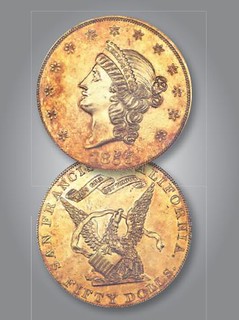 A man by the name of
DeWitt S. Smith once owned
one of the most interesting
and complete collections of
pioneer gold coins ever issued in
California, Oregon, Utah and Colorado.
In addition, his assemblage
of American colonial pieces was
considered by many to be the finest
known, and he also acquired a
number of rare silver pieces and one
or two very rare early copper cents.
A man by the name of
DeWitt S. Smith once owned
one of the most interesting
and complete collections of
pioneer gold coins ever issued in
California, Oregon, Utah and Colorado.
In addition, his assemblage
of American colonial pieces was
considered by many to be the finest
known, and he also acquired a
number of rare silver pieces and one
or two very rare early copper cents.
From the 1860s until his death in 1908, Smith made a fortune in the paper manufacturing industry and, to a degree, the banking business. Both of these endeavors gave him the financial means to purchase many of the most sought-after coins available at the time. Well-known numismatist Thomas L. Elder once called Smith “one of the world’s greatest numismatists.” Upon the latter’s death, Elder stated, “No American numismatist was more highly respected, [and] no other will be more sorely missed from the collectors’ ranks.”
DeWitt S. Smith entered the world on April 4, 1840, and was one of four children born to Jared and Caroline Sheldon Smith of Sandisfield, Berkshire County, Massachusetts. His family moved to Lee, also in Berkshire County, where Smith attended Alexander Hyde School. After the Civil War began, he enlisted in the Union Army and was a second lieutenant in the 49th Massachusetts Infantry. He served from September 1862 to September 1863, and was a captain of Company 8 during the Battle of Port Hudson.
As mentioned, Smith was involved in the banking business and served as vice president of the Lee Savings Bank and as a director of the Lee National Bank. He also was an active Mason until his health declined in the early 1900s.
In the late 1880s, Lee’s postmaster, Carl Wurtzbach, showed Smith his collection of Andrew Jackson tokens, sparking his numismatic interest and serving as the catalyst for what would become the amazing DeWitt S. Smith Coin Collection.
Wurtzbach had amassed an amazing collection of coins, china and antique furniture. However, it was his coins that turned Smith’s head. Smith immediately gave Wurtzbach $500 to purchase coins for him.
Over the course of 20+ years, Smith purchased amazing U.S. pioneer gold rarities, such as the 1849 Templeton Reid $25 gold piece (made in either Georgia or California), of which only one is known. (This gold coin might have been stolen from the U.S. Mint’s collection in 1858 and may have become part of Virgil Brand’s extensive collection after Smith’s death. We will follow up on this interesting piece in another column.)
Smith also owned the extremely rare 1849 J.S. Ormsby & Company gold $10 California specimen, for which he paid $1,310; one of only three known 1850 gold $5 coins from Dubosq & Company; and the very rare 1851 $5 gold piece made by Dunbar & Company. He also possessed one of 13 known Kellogg & Company $50 gold pieces struck in California in 1855.
 Other rare coins owned by
Smith included what has often
been considered “America’s first
coin,” which was an undated 1652
Massachusetts Bay Colony New
England shilling designed and
struck by John Hull and Robert
Sanderson in Boston. This coin
represents an extremely rare die
variety of which only 13 other
pieces are known, with Smith’s
example being one of the finest.
Other rare coins owned by
Smith included what has often
been considered “America’s first
coin,” which was an undated 1652
Massachusetts Bay Colony New
England shilling designed and
struck by John Hull and Robert
Sanderson in Boston. This coin
represents an extremely rare die
variety of which only 13 other
pieces are known, with Smith’s
example being one of the finest.
Although he suffered paralyzing strokes in his later years, Smith’s interest in coins and collectors continued until the day before his death on June 25, 1908. In fact, he wrote a letter on June 24 inquiring about a colonial coin he wished to purchase. He was 69 years old when he passed. Famous numismatists such as Wurtz bach, S. Hudson Chapman and J.C. Mitchelson attended his funeral.
Smith left behind his wife, four sons and a daughter. Soon after Smith’s death, his gold coin collection went up for sale. A 1908 edition of The Numismatist reported the following:
For more information on the American Numismatic Association, see:
www.money.org
PROFESSOR ANDRE’S ALPINE CHOIR TOKEN
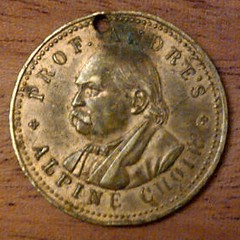
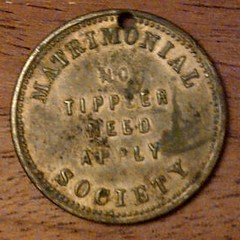
David Pickup writes:
Here are photos of a token I bought yesterday. The inscriptions are "Prof Andre’s Alpine Choir" and "Matrimonial Society No tippler need apply". It seems to be about 1880s and cost me 50 pence!
There is plenty on the web about his Alpine Choir which did concerts for the temperance movement. I have not found who he (Prof Andre) was or what was the Matrimonial Society!
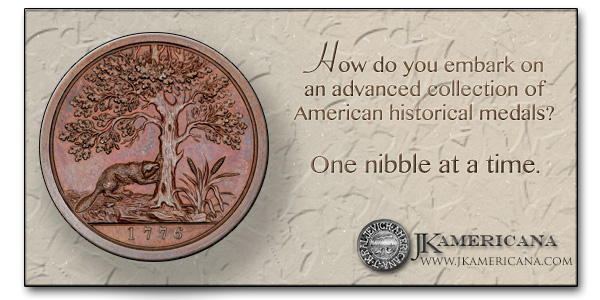
MORE REBUS PUZZLES
Fordham's, Montrose, PA

Regarding Dave Schenkman's advertising note featuring a rebus puzzle, Chip Howell writes:
"Inn for ma shun two awl pear ents B sure two awl ways pur chase silver tipped boot laced shoes they last three times long R than shoes knot protected with tips awl this will B x plane d by calling at..."
Bob Neale writes:
Information to all parents. Be sure you always purchase silver tipped boots (and overshoes?). They last 3 times longer than shoes not protected with tips. All this will be explained by (personally?) calling at C.O. Fordham's.
Pete Smith writes:
"Information to all parents, be sure you always purchase silver tipped boots and shoes. They last three times longer than shoes not protected with tips. All this will be explained by calling at (merchant)."
This was previously published in Paper MoneyS, Vol. XXIX, No. 5, Whole No. 149, October 25, 1990.
Rebus #2: J. Pels & Son, Baltimore. MD
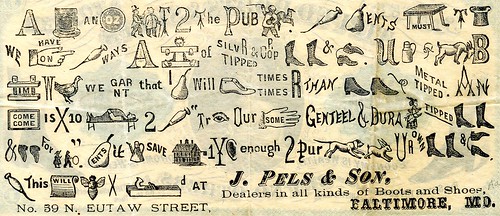
To read the earlier E-Sylum article, see:
REBUS PUZZLE: FORDHAM'S, MONTROSE, PA
(www.coinbooks.org/esylum_v18n42a27.html)
HUTZLER'S STAMP AND COIN DEPARTMENT

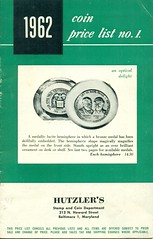
The coin shop in Hutzler's department store in Baltimore was part of the Friedberg chain.
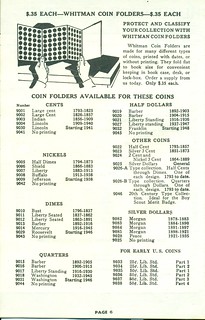 Attached are scans from 1961 and 1962 issues of coin price lists from Hutzler's Stamp and Coin Department. The 1961 issue includes an ad for the Whitman blue folders while the 1962 does not include either the Whitman folders or the Treasury of Coins.
Attached are scans from 1961 and 1962 issues of coin price lists from Hutzler's Stamp and Coin Department. The 1961 issue includes an ad for the Whitman blue folders while the 1962 does not include either the Whitman folders or the Treasury of Coins.
Regarding the Stamp and Coin News, the issue I have from Hutzler's has a Christmas tree on the front and would, I believe, have been 1961 or 1962. The only numismatic offerings were Library of Coins albums, no Whitman or Treasury and no coins or paper money listed.
My recall is that the Treasury of Coins began in 1962. I spent a week in Gimbel's, New York in 1962 and I recall having them at that time.
To read the earlier E-Sylum article, see:
HOLLINBECK COIN SHOPS COIN BOARD STAMPS : Gimbel's Stamp and Coin News Sought
(www.coinbooks.org/esylum_v18n42a26.html)
THE BOOK BAZARRE
MORE ON PRESS RUNS OF NUMISMATIC LITERATURE
I've followed with interest the discussion on the print run of numismatic titles. Here are a few further thoughts on press runs of numismatic books.
But before that, let me introduce myself. I am a professional working in the publishing industry, in a domain which has nothing to do with numismatics. I have also been an enthusiastic collector of fourth century coins for twenty years. Last year, these two facets of of my life coincided when I published a book on fourth century coins - more info can be found here: www.lateromanbronzecoins.com.
I am absolutely convinced that the future of numismatic publishing lies in print-on-demand. Traditional publishing of numismatic books is a risky business. Numismatics is a niche market and apart from a few general titles, most numismatic books are a niche within a niche. Because the best-case scenario sales figures for most titles is at best a couple of thousand (and even then, a lot of titles will sell at most a couple of hundred copies), print-runs are fairly low.
A low print run means more expensive titles. More expensive titles means that within the limited set of people who potentially interested, people are more likely to hesitate before buying, which drives the numbers further down.
Another aspect is that books need to be stored and stocked. In an uncertain market, they might have to be stored for a long time before they are sold. This further drives prices up.
So, enter the print-on-demand book. It is stored as a computer file or set of files. Every time someone wants to buy the book, a copy is printed. Most big companies have deals with distributors and printers throughout the world, which means that your book gets printed locally before being sent to you. No decisions to be taken about print runs, no stocks to deal with, very little risk.
I think that the publishing industry needs to take a good hard look at itself. In order to survive, traditional publishing houses are going to have to review many aspects of their publishing model in order to keep costs down and to ensure that books don't go out of print - I truly think that digital print-on-demand is the way to go, as there are no stocks to keep and the publishing file is available indefinitely. It's sad that an important company like Spink can't even maintain a full set of the Roman Imperial Coinage in print.
The reason I published my book is that I was keen to revive a title (Guido Bruck's Die spätrömische kupferprägung that had faded into obscurity after it went out of print. So much information is being lost to the general public in this way. I'm happy to say that it has sold as many copies as I thought it would, that I haven't lost any money, that I'm not sitting on a pile of unsold books and that a classical title has been rescued and will never be out of print again.
To read the earlier E-Sylum articles, see:
QUERY: PRESS RUN FOR A NEW BOOK ON NUMISMATICS
(www.coinbooks.org/esylum_v18n40a19.html)
THOUGHTS ON PRESS RUNS OF NUMISMATIC BOOKS
(www.coinbooks.org/esylum_v18n41a07.html)
MORE ON PRESS RUNS OF NUMISMATIC BOOKS
(www.coinbooks.org/esylum_v18n42a08.html)
MORE ON 'JEFFERSON DAVIS - HIS MARQUE'
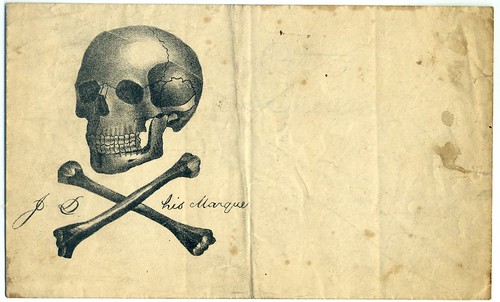
Anti Jeff Davis - Civil War Cover
www.glabarre.com/item/Anti_Jeff_Davis_Civil_War_Cover_SOLD/1732/c6
JD His Marque Jefferson Davis Civil War Confederate Skull Crossbones
www.flickr.com/photos/8558315@N05/14068009289
This bad boy envelope is rather large at 5.25 Inch by 8.5 Inch. The theme dates to the Civil War Patriotic Propaganda Covers but, as noone has seen anything like it, it may date to a later era of the 1880s-1900s. The experts say that due to the rather large size it is mos likely not 1860s. But, as it cost me $5 at a postcard show and is the best skull graphic I have ever found I am still overly pleased with myself.
The JD his Marque refers to a New York Times civil war article relating how Jefferson Davis of the Confederacy had marked all Northern Ships raiding Southern ships as Pirates.
There are contemporary articles that specifically mention Davis soliciting and directing pirates:
The Pirate Flag.
Published: April 20, 1861
(www.nytimes.com/1861/04/20/news/the-pirate-flag.html)
Preparing for Privateers.
Published: April 21, 1861
(www.nytimes.com/1861/04/21/news/preparing-for-privateers.html)
So the cover is likely an anti-Davis item.
To read the earlier E-Sylum article, see:
NOTES FROM E-SYLUM READERS: OCTOBER 18, 2015 : Jefferson Davis - His Marque
(www.coinbooks.org/esylum_v18n42a11.html)

AN 1861 'CONFEDERATE STATES BULL RUN QUARTER'
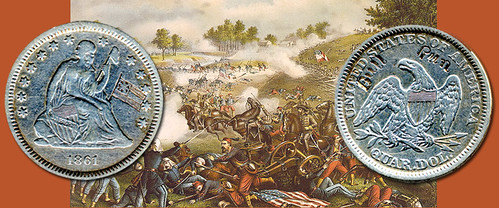
The First Battle of Bull Run or First Manassas (depending on which side of the Mason-Dixon Line you found yourself on) was fought in the Washington, DC suburb of Manassas, Virginia on July 21, 1861. The first serious ground battle after the Confederate bombardment of Fort Sumter in April of the year, “Bull Run” aptly describes the Union Army as it stampeded as fast as it could away from the victorious Confederate forces who took the field that day. Bull Run was a test of two raw armies, and the Confederate victory, though modest, sent a message to the entire country that warfare and death were here to stay.
The first of three Confederate flag designs was called the “Stars and Bars,” and was adopted by the Confederacy March 1, 1861, a month before the events at Fort Sumter. The first adaptation of the flag contained a circle of seven stars in a blue field and three horizontal stripes, red, white, and red. By November of 1861 there were 13 stars in the circle. It was a rather attractive flag, based as it was on Old Glory, and offered no resemblance to the Confederate flag most people are familiar with today.
The 1861 “Confederate” Liberty Seated quarter I have in my exonumia collection is certainly unique. In the right obverse field a Confederate Stars and Bars flag has been etched, two red stripes with the white stripe in between, and seven tiny stars in a circle. On the reverse “Bull Run” in fancy script arcs in a curve above the eagle. I can’t be certain that this unusual piece was actually made in 1861 by a Confederate soldier or sympathizer, but the wear is such that it could have been made from a freshly minted 1861 quarter and then carried as a pocket piece. Like so many other items in my exonumia collection, this “Confederate quarter” has a story to tell – this is one coin I wish could speak!
To read the complete article, see:
“My 1861 Confederate States Bull Run Quarter”
(www.stacksbowers.com/NewsMedia/Blogs/TabId/780/ArtMID/
2678/ArticleID/65422/%E2%80%9CMy-1861-Confederate
-States-Bull-Run-Quarter%E2%80%9D.aspx)
LOUIS GOLD ITEM IDENTIFIED AS A TOOL CHECK
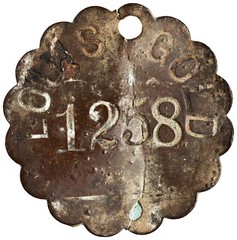
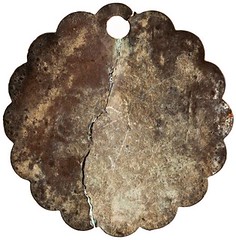
A reader has (we think rightly) speculated that this is a “tool check,” i.e., a tag that was attached to a particular tool in an industrial or construction setting that identified it as the property of the company. Individual or contract workers would thus “check out” and return tools as needed. See, for example, this eBay listing for a metal tool check from the Hudson Car Co., which includes the warning ”Penalty for loss twenty five cents.”
It has also been observed that there was a man named Louis Gold who was a prominent NYC builder during the early 20th century. Gold was a Russian Jewish émigré and has a fascinating life story, which you can read more about in the profile reproduced from the Brooklyn Eagle below. The short story for our purposes is that Gold owned a large building company, one that more likely than not employed a tool check system for its workers. The inscription “LOUIS GOLD” and accompanying serial number would make perfect sense in this context.
To read the complete article, see:
MYSTERIES FROM THE VAULT: LOUIS GOLD BADGE
(www.anspocketchange.org/mysteries-from-the-vault-louis-gold-medal/)
To read the earlier E-Sylum article, see:
QUERY: LOUIS GOLD MEDAL INFORMATION SOUGHT
(www.coinbooks.org/esylum_v18n19a32.html)
QUERY: H.R.C. CLOCK TOKEN INFORMATION SOUGHT
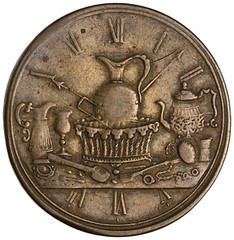
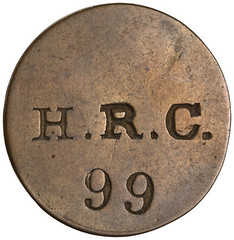
This token is 26 mm in diameter and weighs 4.19 grams, with a die axis of 12. One side has a table top still-life scene wreathed by Roman clock numbers; the other is embossed with the initials H.R.C. and the number 99. It was purchased by the American Numismatic Society as part of a lot of 200 tokens purchased from Schindler’s Antique Shop of Charleston, South Carolina. Click to enlarge the images if you need a closer look.
To read the complete article, see:
MYSTERIES FROM THE VAULT: H.R.C. CLOCK TOKEN
(www.anspocketchange.org/mysteries-from-the-valut-h-r-c-clock-token/)
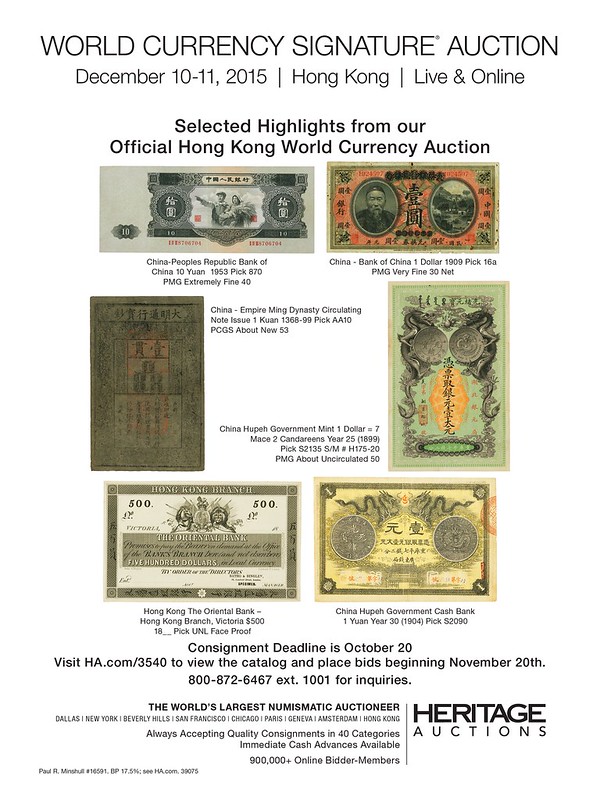
REINVENTING THE LIBRARY
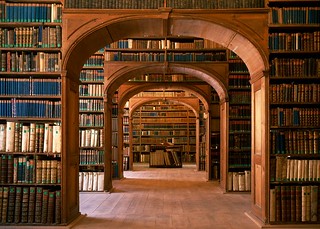 Intent on surviving in an age where the intellectual act has lost almost all prestige, libraries have become largely social centers. Most libraries today are used less to borrow books than to seek protection from harsh weather and to find jobs online, and it is admirable that librarians have lent themselves to these very necessary services that don’t traditionally belong to their job description. A new definition of the role of librarians could be drafted by diversifying their mandate, but such restructuring must also ensure that the librarians’ primary purpose is not forgotten: to guide readers to their books.
Intent on surviving in an age where the intellectual act has lost almost all prestige, libraries have become largely social centers. Most libraries today are used less to borrow books than to seek protection from harsh weather and to find jobs online, and it is admirable that librarians have lent themselves to these very necessary services that don’t traditionally belong to their job description. A new definition of the role of librarians could be drafted by diversifying their mandate, but such restructuring must also ensure that the librarians’ primary purpose is not forgotten: to guide readers to their books.
Libraries have always been more than a place where readers come to read. The librarians of Alexandria no doubt collected things other than books: maps, art, instruments, and readers probably came there not only to consult books but also to attend public lectures, converse with one another, teach and learn. And yet the library remained principally a place where books, in all their various forms, were stored for consultation and preservation of “ancient traditions or notions ‘gray with time’.” Other institutions fulfilled other complementary tasks necessary in a civilized society: hospitals, philanthropic associations, guilds.
Librarians today are forced to take on a variety of functions that their society is too miserly or contemptuous to fulfill, and the use of their scant resources to meet those essential social obligations diminishes their funds for buying new books and other materials. But a library is not a homeless shelter (at the St. Agnes library in New York, I witnessed a librarian explaining to a customer why she could not sleep on the floor), a nursery or a fun fair (the Seneca East Public Library in Attica, Ohio, offers pajama parties), or a prime provider of social support and medical care (which American librarians today nonetheless routinely give).
All these activities are good and useful, and may grant libraries a central role in society once again, but we must be prepared to invest the system with more, not less funds, to allow it to reinvent itself. Librarians are not trained to act as social workers, caregivers, babysitters or medical advisers. All these extra tasks make it difficult, if not impossible, for librarians to work as librarians: to see that the collections remain coherent, to sift through catalogues, to help readers read, to read themselves. The new duties imposed on them are the obligations of civilized societies toward their citizens, and should not be dumped pell-mell onto the shoulders of librarians. If we change the role of libraries and librarians without preserving the centrality of the book, we risk losing something irretrievable.
Every economic crisis responds, first of all, by cutting funds to culture. But the dismantling of our libraries and changing their nature is not simply a matter of economics. Somewhere in our time, we began to forget what memory — personal and collective — means, and the importance of common symbols that help us understand our society.
If libraries are to be not only repositories of society’s memory and symbols of its identity but the heart of larger social centers, then these changes must be made consciously from an intellectually strong institution that recognizes its exemplary role, and teaches us what books can do: show us our responsibilities toward one another, help us question our values and undermine our prejudices, lend us courage and ingenuity to continue to live together, and give us illuminating words that might allow us to imagine better times. According to the Greek historian Diodorus Siculus, one of the ancient libraries he saw in Egypt carried above its entrance the words: “Clinic of the Soul.”
To read the complete article, see:
Reinventing the Library
(www.nytimes.com/2015/10/24/opinion/reinventing-the-library.html)
NEWMAN FOUNDATION: REIMAGINING OLIN LIBRARY
Combining the best of library and museum experiences may seem like a daunting task to most. For philanthropists Eric and Evelyn Newman, and Washington University Trustee Andy Newman and his wife, Peggy Newman, the concept hit home.
Eric Newman, a leading numismatic scholar and a collector who graduated from Washington University School of Law in 1935, and his late wife, Evelyn, a former marketing expert and successful fundraiser, worked as a team for 75 years. “Every night at the dinner table, there was always animated discussion of the newest charitable project they were working on,” said their son, Andy Newman. “It was fascinating and inspiring to watch their creative partnership in action.”
 With the generosity of the Eric P. and Evelyn E. Newman Foundation and the Eric P. Newman Numismatic Education Society (EPNNES), the Newmans have provided the lead gift — $10 million — for the needs of the Olin Library. Their commitment will transform the library into a bustling crossroads, with new entrances on the building’s north and east sides, as well as a destination for students, researchers and visitors from around the world.
With the generosity of the Eric P. and Evelyn E. Newman Foundation and the Eric P. Newman Numismatic Education Society (EPNNES), the Newmans have provided the lead gift — $10 million — for the needs of the Olin Library. Their commitment will transform the library into a bustling crossroads, with new entrances on the building’s north and east sides, as well as a destination for students, researchers and visitors from around the world.
Evelyn Newman, whose imagination and creative flair inspired many aspects of the project, passed away on Sept. 1.
“My mother was delighted to see so many of her ideas for the space being implemented in the physical plans,” Andy Newman said, “and we will all work hard to fulfill her vision.”
The Newman Ephemera Collection includes a broadside of the Declaration of Independence printed in Newport, R.I., by S. Southwick and dated July 13, 1776, and a Blaeu atlas of the Americas, published in 1665 by Joan Blaeu and his father, Willem.
Included in the Newmans’ commitment is a gift made in 2014 by the EPNNES to fund the Newman Numismatic Portal, an online research tool that will become the ultimate resource for the study of coins and currency. The family also is donating Andy Newman’s collection of Scientific American magazines, dating from its first issue in 1845.
“The Newman family has generously contributed to the success of Washington University and its many centers of excellence,” Chancellor Mark S. Wrighton said. “Their remarkable support of the University Libraries represents the cornerstone of our plan to meet the needs of scholars and libraries into the 21st century. They will share the best of their scholarly expertise, extensive travel, adventurous spirit and creativity to bring a spectacular vision for the Newman Tower to life.”
To read the complete article, see:
Reimagining Olin Library
(https://news.wustl.edu/news/Pages/olin-library-transformation.aspx)
WAYNE'S NUMISMATIC DIARY: OCTOBER 25, 2015
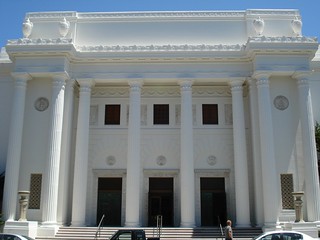 This week my role as a consultant to the Newman Numismatic Portal (NNP) took me across the country to San Francisco, where I attended a great conference at the Internet Archive. "Building Libraries Together" was attended by librarians and Internet Archive staff from around the world. I had been impressed by the organization in the past, and came away even more so. Attending with me were NNP Project Coordinator Len Augsburger, and Chris Freeland and Robert Manley of the Washington University Libraries at Washington University in St. Louis.
This week my role as a consultant to the Newman Numismatic Portal (NNP) took me across the country to San Francisco, where I attended a great conference at the Internet Archive. "Building Libraries Together" was attended by librarians and Internet Archive staff from around the world. I had been impressed by the organization in the past, and came away even more so. Attending with me were NNP Project Coordinator Len Augsburger, and Chris Freeland and Robert Manley of the Washington University Libraries at Washington University in St. Louis.
First, some background on the organization:
The Internet Archive (archive.org) is a 501(c)(3) non-profit that was founded to build an Internet library, with the purpose of offering permanent access for researchers, historians, and scholars to historical collections that exist in digital format.
Founded in 1996, the Internet Archive has an historical web collection (the Wayback Machine) of over 150 billion web pages, about 240,000 movies, over 500,000 audio items (including over 70,000 live concerts), over 1,800,000 texts, 1600 education items, and over 30,000 software items. And we’re growing bigger every day!
Those stats are out of date - the Wayback Machine alone now holds over 439 billion (yes, billion with a "b") web pages and over 8 million books (and 1,000 and counting of these are NNPs). Sure, Google Books has more, but it's a commercial firm with commercial interests at heart. Archive.org is a nonprofit completely committed to the effort (which Google has quietly dropped the ball on). And it's in for the long haul. The REALLY long hall. Their leadership isn't just interested in preserving this digital material for the next 50 years - they're thinking 500 years and beyond.
To me, Brewster Kahle and his team at Internet Archive are today's 'Monuments Men' See the articles linked below for more information.
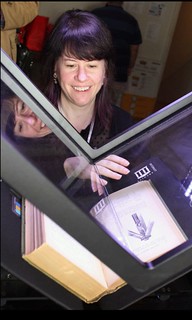 Our initial connection with IA is in the digitization realm. Via a contract with Washington University in St. Louis (WUSTL) and the NNP, Internet Archive installed state-of-the-art scanning equipment at WUSTL and sent a technician to set it up and train WUSTL staff.
Our initial connection with IA is in the digitization realm. Via a contract with Washington University in St. Louis (WUSTL) and the NNP, Internet Archive installed state-of-the-art scanning equipment at WUSTL and sent a technician to set it up and train WUSTL staff.
While robots may take over this task in the future, people are still the best page-turners for this repetitive but important task. With human help the machines digitize two pages at once to the current tune of about 7,000 pages a month.
The staff and volunteers I spoke with were amazing. This is a very talented and dedicated group of people. They are working on a number of features, enhancements and projects that could benefit users of the Newman Numismatic Portal as well as the entire Internet Archive community.
It was a nice quick trip. I saw little of San Francisco besides the airport and the drive there and back, but I was glad to get there. The Internet Archive headquarters is in a great old building, a former church bordering on the Presidio. It's a fitting structure - a temple of knowledge. Our main conference sessions took place in the former sanctuary under an amazing dome.
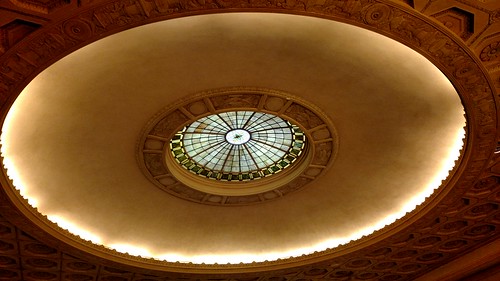
The high-tech outfit has a great human side. Everyone was friendly and helpful. And in a riff on the Terracotta Warriors of China, every employee who reaches their three-year mark is memorialized with a personal "mini-me" statue. Very cool.
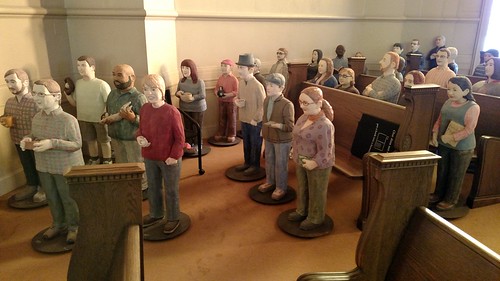
Anyway, thanks again to our hosts and to the Eric P. Newman Numismatic Education Society (EPNNES) for making the Newman Numismatic Portal project possible. Stay tuned, everyone.
To visit the Internet Archive site, see:
https://archive.org
To visit the NNP Collection on Internet Archive, see:
https://archive.org/details/newmannumismatic
To read some good articles on the Internet Archive, see:
The Creator of the Internet Archive Should Be the Next Librarian of Congress
(www.slate.com/blogs/future_tense/2015/09/10/
brewster_kahle_creator_of_the_internet_archive_
should_be_the_next_librarian.html)
Introducing the Archive Corps
(www.theatlantic.com/technology/archive/2015/09/
introducing-the-archive-corps/403135/?utm_source=SFTwitter)
THE BOOK BAZARRE
MONUMENTS MEN RECEIVE CONGRESSIONAL GOLD MEDAL
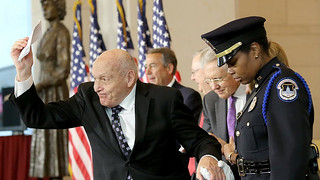 Before Richard Barancik was a successful Chicago architect, he helped safeguard some of Europe's most valuable pieces of Western culture plundered by the Nazis.
Before Richard Barancik was a successful Chicago architect, he helped safeguard some of Europe's most valuable pieces of Western culture plundered by the Nazis.
Seventy years later, it remains difficult for him to fathom the theft of millions of paintings, sculptures, drawings, pieces of furniture and other objects at the close of World War II, detailed by Robert Edsel in his 2009 book, “The Monuments Men: Allied Heroes, Nazi Thieves, and the Greatest Treasure Hunt in History.” The book was made into a film by George Clooney.
“All for their own selfish pursuit,” Barancik said on Thursday, before he and three of the surviving “Monuments Men” — Harry Ettlinger, Motoko Fujishiro Huthwaite and Bernard Taper — were honored with the Congressional Gold Medal, one of the nation's highest civilian awards.
They were members of an Allied armies unit assigned to recover the works of art stolen from homes, museums, churches and elsewhere. The approximately 350 civilian soldiers — mostly middle-aged men and women who were historians, architects and museum personnel prior to the war — were part of the Monuments, Fine Arts and Archives section.
“Their initial responsibility was to mitigate combat damage, primarily to structures — churches, museums, and other important monuments,” Edsel wrote of the Monuments Men. “As the war progressed and the German border was breached, their focus shifted to locating movable works of art and other cultural items stolen or otherwise missing.”
In May 2014, Congress voted overwhelmingly to award the Congressional Gold Medal to the unit for their heroic role in preserving works of cultural importance. Relatives of deceased Monuments Men also attended Thursday's bipartisan ceremony, along with members of Congress.
Hitler had planned to house the stolen art in a museum in his hometown of Linz, Austria.
“They sold more modern works, such as Impressionist pieces, and used proceeds to purchase works they sought for the Linz collection,” Campbell Karlsgodt wrote. “Others they considered ‘degenerate' — Surrealist, Expressionist and Cubist pieces, and they burned thousands of them in Berlin and Paris.”
Ettlinger, who was born to a Jewish family in Germany before moving to New Jersey and being drafted by the Army, said the world should not forget that the spoils of war do not always belong to the victor.
To read the complete article, see:
'Monuments Men' are honored with Congressional Gold Medal
(www.latimes.com/nation/la-na-monuments-men-congressional-gold-medal-20151022-story.html)
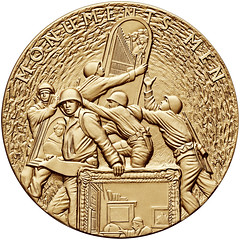

Obverse
Designer: Joel Iskowitz
Engraver: Phebe Hemphill
Description: a portrayal of soldiers in action, lifting and removing objects from a cave or mine location where Monuments Men discovered stolen works. The artwork depicted represents major works of historic significance the group recovered. The design includes the inscription “MONUMENTS MEN.”
Reverse
Designer: Donna Weaver
Engraver: Joseph Menna
Description: features some of the thousands of works of art that were at risk from damage, destruction or theft by Nazi forces, surrounding the inscriptions “IT IS OUR PRIVILEGE TO PASS ON TO THE COMING CENTURIES TREASURES OF PAST AGES” and “GEN. DWIGHT D. EISENHOWER.” The design also includes the inscription “ACT OF CONGRESS 2014.”
To read the complete article, see:
Monuments Men Receive Congressional Gold Medal
(www.usmint.gov/pressroom/?action=press_release&id=1725)
ROYAL CANADIAN MINT UNVEILS TWO NEW DESIGNS
 On Friday morning, representatives of the Royal Canadian Mint came to Guelph and unveiled two new designs for a $2 coin and a quarter to be released into circulation. The big reveal was held at the McCrae House at 10 a.m. and around 100 people were in attendance.
On Friday morning, representatives of the Royal Canadian Mint came to Guelph and unveiled two new designs for a $2 coin and a quarter to be released into circulation. The big reveal was held at the McCrae House at 10 a.m. and around 100 people were in attendance.
The new quarter features a natural-looking poppy in the foreground surrounded by smaller poppies in the background. The mint will circulate around 12.5 million of these new quarters. Half of them will be in colour, with the poppy standing out in bright red.
The $2 coin features Lt.-Col. John McCrae writing the poem "In Flanders Fields" in 1915. Rows of crosses are seen in the background and a lark is also seen flying by. A total of five million of these coins will soon be circulating throughout the country.
The coins were created in recognition of the 100th anniversary of the writing of "In Flanders Fields" by McCrae, a native of Guelph.
Former cabinet minister and Second World War veteran William Winegard said the city was proud of McCrae and happy to have such a role in the unveiling of these coins.
"Guelph and Ottawa now have statues of McCrae actually writing the poem, but now with your help, the whole country can see John McCrae and can see the poppy," he said.
Reeves wouldn't reveal the cost of creating these coins, but said the public could pick them up at face value.
Ten-year-old Tate Oldreive attended the event with the rest of his classmates from John McCrae Public School. Emptying a small plastic bag into his hands, he counted out $5 in change and handed it over to a man distributing the new coins.
He picked up two commemorative booklets, each one containing the new toonie and the two quarter designs.
"They're cool," he said, adding he was going to give one to his parents.
Eleven-year-old Alexandra Petrie said she was really excited to take home these new coins. The student said she is an avid coin collector, just like her father, with 50 or so coins in her collection.
"These are going to be the best in my collection," she said, looking down at the coins and smiling.
The designs of these coins represent an important part of Canadian history and contribute to the Canadian identity, she said. The poppy in particular illustrates how we as Canadians value our past and how important it is to never forget.
To read the complete article, see:
Guelph’s McCrae and the poppy to be seen on coins throughout the country
(www.guelphmercury.com/news-story/6033133-guelph-s-mccrae-and-the-poppy-to-be-seen-on-coins-throughout-the-country/)
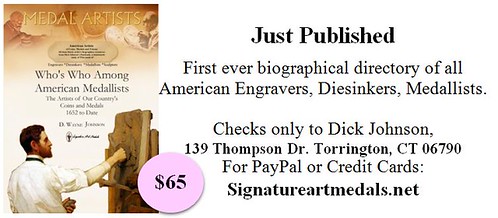
NEW INTERNATIONAL COIN SHOW PLANNED FOR CHICAGO
HJB Ltd. has announced that the firm will not be holding a Gemini auction at the upcoming 2016 New York International Numismatic Convention. Instead the firm plans to organize an important new numismatic convention in downtown Chicago, at which future Gemini auctions will be held.
HJB Ltd. has its roots in the Chicago area, where Harlan J. Berk established his numismatic firm in 1964. Today the firm is internationally known for its ongoing Buy or Bid sales and numismatic auctions. Yet the firm still feels an obligation to promote numismatics in the city of Chicago itself.
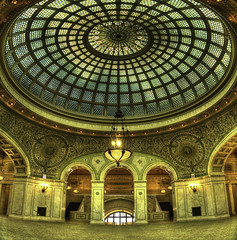 Hence the plan to re-establish an international coin show in downtown Chicago. As Shanna Berk-Schmidt says, “Every day during my lunch break I walk past the splendid building of the Chicago Cultural Center. For years I have thought that this would be the ideal place to hold a fantastic coin convention. Here we are in the heart of downtown Chicago, thousands of local people and tourists walk by the Chicago Cultural Center every day. Here we could really focus public attention on numismatics, our great passion. Now I want to turn my dream into reality! We will be organizing a coin show in this marvelous building with its impressive glass dome.”
Hence the plan to re-establish an international coin show in downtown Chicago. As Shanna Berk-Schmidt says, “Every day during my lunch break I walk past the splendid building of the Chicago Cultural Center. For years I have thought that this would be the ideal place to hold a fantastic coin convention. Here we are in the heart of downtown Chicago, thousands of local people and tourists walk by the Chicago Cultural Center every day. Here we could really focus public attention on numismatics, our great passion. Now I want to turn my dream into reality! We will be organizing a coin show in this marvelous building with its impressive glass dome.”
Harlan Berk, Shanna’s father, added that he has been trying for decades to interest more people in numismatics, “and that for many other reasons than just to win them as customers! For that reason we have decided to make the new coin convention a not-for-profit business. It is our goal to recreate an important coin show in downtown Chicago, at which numismatics will receive the attention it deserves.”
The new Chicago show will be held for the first time in spring 2017, and preparations are already underway. Harlan Berk intends to organize a rich program of supplementary activities, including panel discussions and lectures and of course also auctions. With this in mind HJB Ltd. has decided to transfer its internationally known Gemini auctions to Chicago.
Aaron Berk stressed that HJB Ltd. will of course continue to be an active participant in the New York International show every January, occupying one of the largest tables on the bourse floor as in previous years.
For additional information and to express interest in reserving a table at the new Chicago coin show in spring 2017, please contact Shanna Berk-Schmidt at shanna@hjbltd.com.
BYZANTINE COIN FOUND IN CARTAGENA COUNTRYSIDE
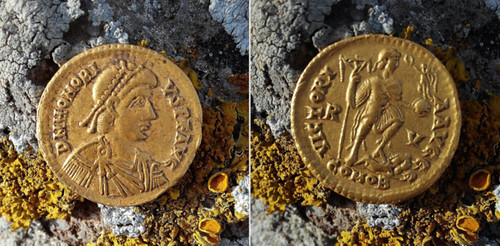
A gold coin dating from the late 4th or early 5th century has been donated to the Department of Culture in the Byzantine coin found in Cartagena countryside Town Hall of Cartagena, and is being kept in the Museo Arqueológico until it is decided which museum it will be displayed in.
The Byzantine solidus coin, which has a diameter of 21 millimetres, was found completely by chance when members of the ANSE naturalists association were enjoying a walk, and was minted in Ravenna (still containing stunning Byzantine mosaics) in the north of Italy during the reign of Emperor Honorius, who was in power from 385 to 423 AD. It is a relatively rare coin, firstly because it was not often used due to its high value, and secondly because most solidi were melted down after being taken out of circulation in order to re-use the gold. In fact, there are only two others currently in the museums of the Region of Murcia.
Around the bust of Honorius on the coin it is possible to read the inscription “DN HONORI-VS P F AVG” (Dominus Noster Honorius Pius Felix Augusto), while on the other side the image portrays the figure of the Emperor as a foot soldier.
The solidus was first introduced by Constantine the Great (324-337) to replace the aureus as part of a monetary reform which helped to stabilize the economy of the Roman Empire, and was later an important element of the economy of the Byzantine Empire (or Eastern Roman Empire). It remained in use in the west until the 9th century and in the east until the 11th century, and was often used in international trade, its longevity being due to its weight and the purity of the gold it contained.
The Byzantines were in Murcia for just a short period, as the bloated Roman Empire collapsed and split. By the 3rd century the vast Empire was falling apart and by the middle of the 4th century waves of Vandals and Goths had begun to gain European territories from Rome. By 476 much of Western Rome was gone and the power base was with the Eastern half of the territories, ruled from Constantinople.
To read the complete article, see:
Byzantine coin found in Cartagena countryside
(http://murciatoday.com/byzantine-coin-found-in-cartagena-countryside_27554-a.html)
THE FIDEM 2007 CONGRESS MEDAL BY SARAH PETERS
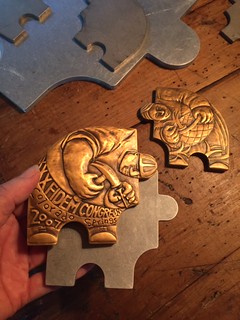 The most under-reported medal in the last decade is the 2007 FIDEM Congress Medal issued by the American Numismatic Association. I mentioned this medal in last week’s E-Sylum article on new coin and medal concepts. I was not entirely clear about what I said, realizing this after it was published Monday morning
The most under-reported medal in the last decade is the 2007 FIDEM Congress Medal issued by the American Numismatic Association. I mentioned this medal in last week’s E-Sylum article on new coin and medal concepts. I was not entirely clear about what I said, realizing this after it was published Monday morning
This week I contacted the artist, Sarah Peters, to learn the facts, resolving to pass on more accurate information. We had met at the FIDEM Congress in Colorado Springs in September 2007. Later she accepted my invitation to come to Connecticut to do a plant tour at Greco Industries in Bethel where the discussion was extensive on medal patinas, the firm’s specialty.
In 2006 FIDEM had issued an invitation for their 30th Congress to world medallists to prepare their medal designs with the theme of Reconstruction following Katrina and other recent disasters The medallic items would be exhibited in Colorado Springs at ANA headquarters.
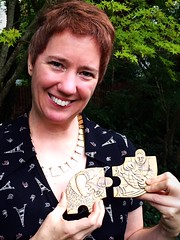 Sarah Peters was one of 31 American artists who accepted that challenge. She made sketches developing concepts for her proposed medal. She wanted a unique design within the prescribed theme. Her final choice was a brilliant concept of a man on one side, a woman on the other, but designed in an arc shape where four quadrant shapes would interlock completing a circle made of the four separate medals.
Sarah Peters was one of 31 American artists who accepted that challenge. She made sketches developing concepts for her proposed medal. She wanted a unique design within the prescribed theme. Her final choice was a brilliant concept of a man on one side, a woman on the other, but designed in an arc shape where four quadrant shapes would interlock completing a circle made of the four separate medals.
Working first with paper patterns she enlisted the aid of her husband Donald, a mechanical engineer. By waterjet he cut four patterns exact shape in sheet aluminum. These fit perfectly when interlocked together proving her concept allowing a small tolerance between the pieces.
The patterns were the exact size of the intended medal. But a relief model required a size four times larger to be reduced pantographically at Medalcraft, the firm the sponsoring ANA had selected to make the medals. She prepared plaster models the necessary size for submission to Medalcraft in Wisconsin.
She describes the obverse male side as a construction worker in hard hat with hammer in one hand, nail in the other. The FIDEM lettered inscription is, in effect, the worker’s tool belt. When the four medals are placed with all four male sides showing, this forms a center open work. The worker is hammering new construction symbolized in this area adhering to the prescribed FIDEM theme.
The reverse shows a female with a basket of seedlings. She is planting these in the area of the open work, symbolizing a reseeding as part of reconstruction. Seedlings are shown at her feet and also growing out of the open area.
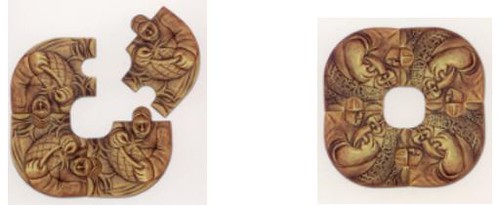
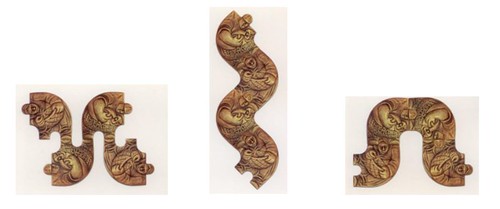
This was such a brilliant, dramatic concept in medallic art that the artist and the ANA as sponsor, are both to be commended. It was an honor extended to FIDEM forming, perhaps, the most significant Congress Medal ever issued in FIDEM’s thirty years of medals in this series. More than just an art medal Sarah Peters’ creation was an outstanding medallic object in the true definition of the term.
The medal in a group of four is certainly a showpiece. I couldn’t wait to acquire a set of four when I attended the 2007 FIDEM Congress. I exhibited them recently to a group of collectors, sculptors and the public. Everyone, after I mentioned they can be rearranged, had to do exactly that – make each of the four different configurations illustrated here.
But what of Sarah Peters? Did it bring her fame and fortune as it should have? The ANA did pay her expenses to attend the FIDEM Colorado Springs Congress, but no other fee. Her fantastic medallic creation went unreported. It should have been trumpeted in all the art and numismatic press!
To read the earlier E-Sylum article, see:
NEW CONCEPTS IN COINS AND MEDALS: FAD OR FASHION?
(www.coinbooks.org/esylum_v18n42a23.html)
THE BOOK BAZARRE
IRELAND'S MEDAL GIVEN TO EU MINISTERS
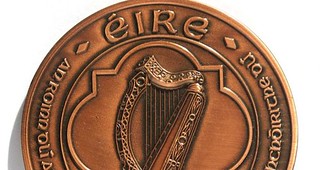 The Irish government used to award medals to EU ministers for attending meetings, it has emerged. This unusual practice came to light following the sale of one of the medals at auction in Dublin.
The Irish government used to award medals to EU ministers for attending meetings, it has emerged. This unusual practice came to light following the sale of one of the medals at auction in Dublin.
Whyte’s auctioneers said a bronze medal, given to one of the participants at a meeting of EU justice ministers, chaired by Ireland and held in Luxembourg in June 2004, had sold for €70 in its auction of historical memorabilia on Saturday .
Under the EU’s system of rotating presidency, the meeting was chaired by former minister for justice Michael McDowell, then leader of the Progressive Democrats in Bertie Ahern’s Fianna-Fáil led coalition government. The medals were given to those who attended. The 75mm medal is a replica of Mr McDowell’s ministerial seal at the Department of Justice, Equality and Law Reform .
It is believed that up to 50 of the medals were commissioned from Lee Brothers Ltd, a company based in Santry, Dublin, which supplies “medals, badges, trophies, awards and corporate gifts” and also offers an engraving service.
It is understood that everyone at the meeting received a medal, among them Belgium’s deputy prime minister, Laurette Onkelinx; Germany’s federal minister for the interior, Otto Schily; Spain’s minister for justice, José Antonio Alonso Suárez; and Sweden’s minister for justice, Barbro Holmberg.
Whyte’s did not say who had consigned the medal for sale but described it as in “extremely fine” condition and still in its original “green leatherette case”. It had a pre-auction estimate of €80-€100.
Afterwards, auctioneer Ian Whyte said the unnamed buyer had got “good value for €70”, as the item was “a very rare medal for collectors” and had sold for “less than the cost of making it”.
To read the complete article, see:
Medal given to EU ministers for attending meeting sells – for €70
(www.irishtimes.com/culture/heritage/medal-given-to-eu-ministers-for-attending-meeting-sells-for-70-1.2398023)
RUSSIAN COIN ON U.N. CONVENTION AGAINST CORRUPTION
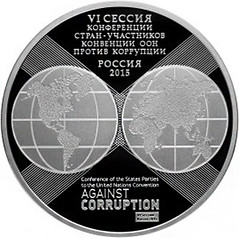
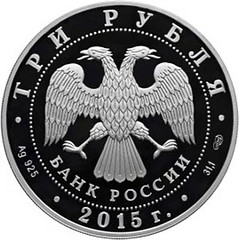
On October 22, 2015, the Central Bank of the Russian Federation issued a silver three-ruble commemorative coin to honor the 10th anniversary of the Conference of the States Parties to the United Nations Convention Against Corruption. The timing of the coin’s release coincides with Russia’s hosting of the Conference’s sixth session, which will be held in Saint Petersburg, Russia on November 2-6, 2015. Limited to a mintage of 3,000 pieces, this .925 silver coin weighs 31 grams and is struck in Proof.
Obverse:
In the center, the two-headed eagle, which is the emblem of the Bank of Russia. Underneath the eagle is the inscription “Банк России” (Bank of Russia). The eagle is surrounded by a beaded circle. Between the beaded circle and the rim is the text ТРИ РУБЛЯ (three rubles) and 2015 Г[од]. In addition, along the rim of the coin is the coin’s metallic purity, represented as “AG 925”; “31,1” representing the coin’s weight; and the mark of the Saint Petersburg Mint.
Reverse:
The Earth’s Eastern and Western Hemispheres are depicted in low relief. Underneath are criss-crossing lines in the shape of an “X” or St. Andrew’s Cross. At the top of the coin are two inscriptions that read VI СЕССИЯ КОНФЕРЕНЦИИ СТРАН-УЧАСТНИКОВ КОНВЕНЦИИ ООН ПРОТИВ КОРРУПЦИИ and РОССИЯ 2015 (“The VI Session of the Conference of the States-Parties to the United Nations Convention Against Corruption” and “Russia 2015”). At the bottom of the coin is the logo of the Conference.
To read the complete article, see:
Russia 2015 United Nations Convention Against Corruption 3 Ruble Silver Coin
(www.coinweek.com/coins/coin-profiles/russia-2015-united-nations-convention-against-corruption-3-ruble-silver-coin/)
DNW OFFER RARE MALAYA AND BRITISH BORNEO BANKNOTES
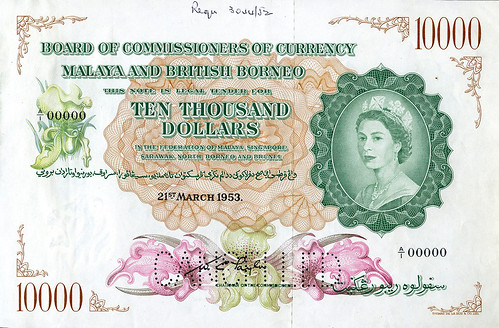
Two extremely rare high denomination banknotes issued in Malaya and British Borneo in 1953 will be among the highlights of a three-day sale of Paper Money, Coins, Tokens and Historical Medals to be held by the international specialists Dix Noonan Webb in London from 7 to 9 December 2015. An extraordinary range of material will be auctioned and the paper money section is an addition to Dix Noonan Webb’s usual two sales a year in this specialist area.
Both Malaya and British Borneo notes are dated 21 March 1953 and bear the signature of W.C. Taylor, Chairman of the newly-established Board of Commissioners of Currency for Malaya and British Borneo. Previously the two territories had issued separate notes. The changeover to the combined currency coincided by chance with the death of George VI, so these notes bore the portrait of Elizabeth II as well as the name of the new Board.

The two to be auctioned by Dix Noonan Webb are a $10,000 note, which is estimated at £12,000 to £15,000, and a $1,000 note, expected to fetch £10,000 to £12,000. Both are extremely rare, with the number of known examples in single figures, and neither of these particular notes has been on the market before. They were produced as specimens to familiarise bank staff handling notes with this entirely new series. Although the $1,000 denomination note was issued to the public, the $10,000 one was restricted to inter-bank usage. Both were high value, the exchange rate at the time being 8.57 Malaya and British Borneo dollars to the pound.
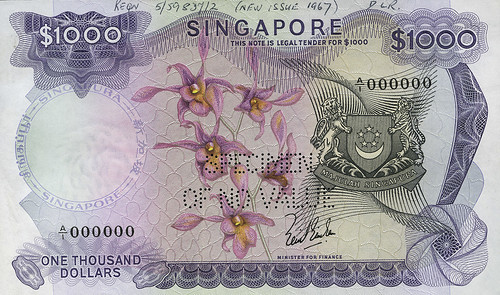
The Dix Noonan Webb auction will also include a Singapore $1,000 specimen note. This is from the first series of notes for Singapore in 1967, known as the ‘Orchid Series’, and the $1,000 is scarce as an issued note and rare as a specimen. This example is estimated at £2,000 to £2,500.
To find out more about the sale visit:
http://www.dnw.co.uk/

SWEDEN AND DENMARK ON PATH TO ELIMINATE CASH
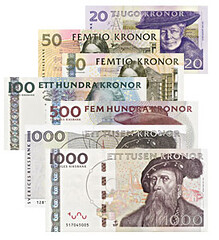 In a world that puts so much stock in the tangible, is it truly possible for a society to go completely “paper free” in regards to their finances?
In a world that puts so much stock in the tangible, is it truly possible for a society to go completely “paper free” in regards to their finances?
It seems that Sweden, among other countries, is quickly moving in that direction. Apparently, a recent study reported that bank notes are quickly on the descent, with digital banking and electronic money becoming the norm. The main culprit in this cash demise is a mobile-banking system which is pushing the digital form of payment ahead. Niklas Arvidsson, a researcher at KTH, declares that “Our use of cash is small, and it’s decreasing rapidly.” There is currently a reported 80 billion Swedish crowns in circulation, a much lower amount than the 106 billion that was in circulation in 2009. Circulation reports from the main bank in Sweden, the Riksbank, support this.
In fact, there are apparently already banks in Sweden with 100% digitalization—where no cash is accepted at all. And branches that do handle paper money or coins have cracked down severely on security, with each customer being required to “explain where the cash comes from, according to the regulations aimed at money laundering and terrorist financing,” says Arvidsson.
Denmark is close behind in this regard—in May this year the Danish government reported that, as of 2016, certain businesses including clothing retailers and restaurants will no longer be legally bound to accept cash as a form of payment. This sounds like a drastic change, but reports say that already one-third of the Danish population uses a mobile banking app for transactions.
The main push-back against going 100% digital is of course security and availability. While the mobile direct-payment app allows individuals to transfer money in real time (solving the question of transactions occurring outside of retail and e-commerce), there remain individuals who do not have access to mobile phones or digital projects, such as certain elderly and those living in rural locations. And the risk of fraud is a significant concern in a fully digital banking system—reports say that in Sweden, “cases of card fraud have doubled in the last decade.” But, hand-in-hand, Sweden has had a “governmental crackdown on corruption” to try and give peace of mind to citizens using electronic forms of payment. There are also questions regarding the international viability of a cashless system. But while the challenges are real and large, they do not appear to be unassailable hurdles: “. . . it is not impossible that a Swish-based (“Swish” is a particular mobile-app) banking revolution can also occur abroad,” says Arvidsson.
Regardless, paper-to-paperless will not be an overnight change—the Riksbank conducted surveys showing that 41% of people making transactions under 100 kronor still prefer cash, and about 7% of the Swedish National Pensioners’ Organization’s members never use bank cards at all. That, in a combination with a fondness for their paper money, will probably keep the transition in Sweden fairly moderate. Arvidsson agrees, stating that “A recent survey I worked on showed that two-thirds of Swedes think carrying cash is a human right . . . it fits in with the identity of being a Swede . . . people like to know their cash is there, even if they don’t necessarily use it.”
Someone commenting on the article wrote:
"... branches that do handle paper money or coins have cracked down severely on security, with each customer being required to “explain where the cash comes from, according to the regulations aimed at money laundering and terrorist financing,”
Just another way for the socialist government to control the masses."
To read the complete article, see:
Sweden to be Cash Free?
(http://news.coinupdate.com/sweden-to-be-paper-free/)
'BACK TO THE FUTURE' PREDICTIONS FOR 2045
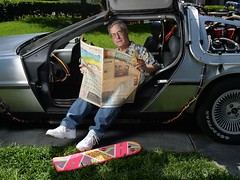 For this edition, USA TODAY asked me to again predict life 30 years in the future. I hope I'll be around to see what I get right.
For this edition, USA TODAY asked me to again predict life 30 years in the future. I hope I'll be around to see what I get right.
In 2045, people will own fewer things. This is already happening as a function of cloud storage for media and the sharing economy. Thanks to Uber and Lyft, and same-day local delivery for almost anything we want to buy, it's easier than ever to function without owning a car, and public self-driving cars in our business districts will accelerate that trend.
Virtual reality will make it easier for people to work from home or from decentralized workplaces, all of which means fewer cars on the road, less wear and tear on our infrastructure, but less tax revenue from auto sales and gasoline taxes. Therefore, our governments will find new ways to tax us and "feed the beast."
A fast food restaurant will be operated by just two people, and some of that fast food will be soy, processed to taste just like chicken and beef. Cashiers will be a thing of the past because transactions will be made via smartphone, with the meals prepared and packaged by robots. Already, store checkers are being replaced by self checkout, and both they and restaurant waiters will become an endangered species.
Advanced robots will handle almost all factory and warehouse labor, and consumers will manufacture smaller items in their own homes with 3-D printers. By 2045, robotic systems will construct buildings and roads. And the most important job in society will be "repair person."
Turning our garbage into energy will prove more efficient than wind and solar power. We'll have "Google MD," a system using biometrics and data crunching to diagnose common ailments from our own homes — a good thing, given an aging population and a likely shortage of doctors. Improved medical technology, data and treatment will lead to longer lifespans, but our new ability to predict future health based on genetics and bio-analysis will result in some difficult moral dilemmas.
Cash will still exist because it will be necessary for bribery and other criminal activity. More recreational drugs will be legalized, newer drugs will be developed, and society might encourage habitual criminals and iconoclasts to live in a drug-induced stupor because it will be cheaper than incarceration.
Although I still don't expect flying cars, there will be hoverboard parks, similar to today's skateparks.
Finally, the people of 2045 will be nostalgic about the simpler life of 30 years ago. They'll wish for a DeLorean Time Machine so they can forget their troubles by visiting that wonderful year, 2015.
To read the complete article, see:
'Back to the Future' writer predicts next 30 years
(www.usatoday.com/story/life/movies/2015/10/22/back-future-yet-again/74240982/)
It takes really high-resolution images. It lets you adjust the depth of field in your pictures after you take a shot. It excels in low light despite having nothing bigger than a smartphone sensor and nothing more expensive than a plastic lens embedded in it. And despite its phone-like face, with no moving parts, it has an optical zoom range of 35mm to 150mm.
To read the complete article, see:
How This Magical 16-Lens Camera Will Actually Work
(www.wired.com/2015/10/light-l16-camera/?mbid=nl_102315)

STATE QUARTERS TRAVEL PAST PLUTO
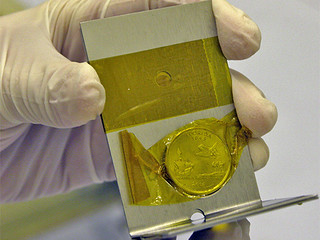 For those eagerly anticipating the next round of images from the New Horizons spacecraft this month, the wait pales in comparison to the journey of two coins.
For those eagerly anticipating the next round of images from the New Horizons spacecraft this month, the wait pales in comparison to the journey of two coins.
Launched Jan. 19, 2006, New Horizons has since traveled over three billion miles, but only reached Pluto in July.
The voyage has not been done alone, however. Accompanying the spacecraft are coins from the U.S. Mint's 50 State Quarters Program. The Maryland and Florida quarters were chosen to honor the states that designed and launched the spacecraft, and they have acted as spin balance weights during the trip.
Illustrator Ralph Butler created the Florida design in a single sitting and entered it into the U.S. Mint's competition at the encouragement of his mother. He added the tagline "Gateway to Discovery" out of respect for Florida's long history of exploration.
"Every artist dreams of a moment of immortality, where your art will live on for your children and grandchildren. . . . To know that the Florida quarter is out there in space is wonderful. I guess it always pays to listen to your mother!"
William Krawczewicz, who designed the Maryland quarter for the U.S. Mint, said he is honored to know his imagery is traveling the far reaches of space. "It's unheard of," said Krawczewicz, who now works as a banknote designer for the Bureau of Engraving and Printing. "It's really amazing that something that I helped to work on has been included in a U.S. space flight mission and is three billion miles away right now. . . . The whole mission itself shows what the American journey is all about . . . living, exploring, and discovering new frontiers."
The voyage of the state quarters to Pluto represents the latest chapter in the love affair between coins and space. Twelve Sacagawea dollar coins rode with the space shuttle Columbia in 1999, while a rare 1909 U.S. penny flew to Mars with the Curiosity rover in 2012.
The article links to a video interview with Maryland state quarter designer William Krawczewicz: Coins in Space (www.youtube.com/watch?v=-gIEbX3ea7M)
To read the complete article, see:
State Quarter Legacy Expands Across the Galaxy
(/www.usmint.gov/pressroom/insidethemint/index.cfm?action=md-fl-state-qtr-galaxy)
MEXICAN INDEPENDENCE ROLEX INCORPORATES GOLD COIN
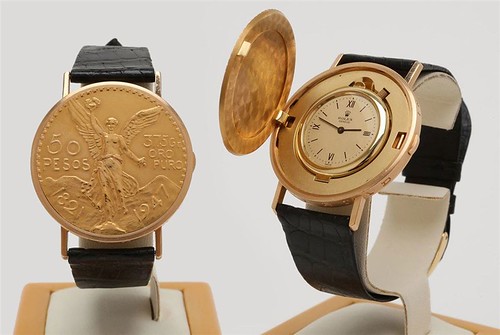
Movement: Manual
Bracelet: Original Black Leather Rolex Strap
Dial: Dual dial with hunting case made of antique Peso coin
Metal: 24k and 18k Yellow Gold
Diameter: 38mm; 48 grams
Circa: 1971
Additional Information: One of 10 pieces made to commemorate the 150th year of the Treaty of Corodoba, Mexican independence from Spain in 1971. This watch has been featured in trusted publications all over the world, including renowned watch periodical Hodinkee. This item is rarely seen for sale, and recently sold at auction for 400,000 HDK or $51,612.
To read the complete article, see:
1971, 1 of 10, Cellini Mexican Independence Rolex
(www.liveauctioneers.com/item/41774777_1971-1-of-10-cellini-mexican-independence-rolex)
FEATURED WEB PAGE: THE CANADIAN ENCYCLOPEDIA
This week's Featured Web Page is the Coins and Tokens page from The Canadian Encyclopedia.First Coins in Canada
The earliest coins in use in what is now Canada were those carried by the first colonists and visitors to our shores. French coins predominated along the St. Lawrence and in other areas under French control; English coins were most common in their territories, and a mix of coins from Portugal and elsewhere dominated along the coast, particularly in Newfoundland, where various nationalities came to fish (see Fisheries History).
French Coins
The first coins struck for use anywhere in Canada were the famous "GLORIAM REGNI" silver coins of 1670, struck in Paris for use in all French colonies in the New World. Few specimens have been found in Canada; the piece of 15 sols is especially rare. In 1672 the value of these coins was raised by one-third in a vain attempt to keep them in local circulation. None were in use after 1680.

www.thecanadianencyclopedia.ca/en/article/coins-and-tokens/
